PLUS:
MIKE LEE ON PUBLIC LANDS & RAÚL LABRADOR ON IMMIGRATION
DESERET MAGAZINE UPC REFERENCE
MARCH

SPECIAL ISSUE STATE OF THE WEST
THE GREAT CALIFORNIA EXODUS
BAD BETS : HOW VEGAS IS TAKING OVER SPORTS
THE OTHER MARCH MADNESS
ALASKA’S MOST REMOTE (AND INSPIRING) BASKETBALL TOURNAMENT
MILITARY SPENDING — BAILOUT OR FALLOUT?
2024
04 | NO 32
VOL
MARCH JULY APRIL SEPTEMBER MAY OCTOBER
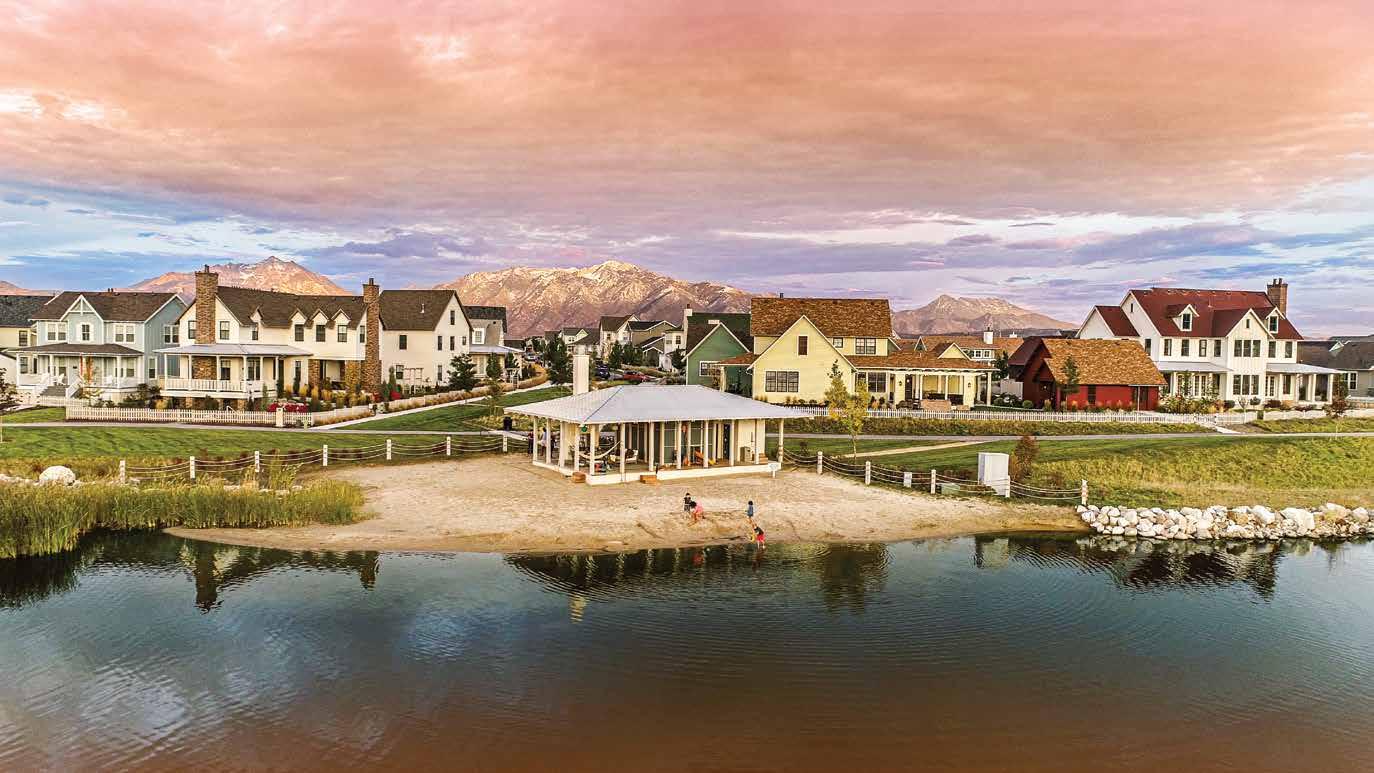

“California has remained a beacon of hope to flock toward. Until now.”



THE OTHER MARCH MADNESS
INSIDE ALASKA'S MOST REMOTE (AND INSPIRING) BASKETBALL TOURNAMENT.
by kade krichko

44
WHAT’S THE MATTER WITH CALIFORNIA?
WHY CRIME, HOUSING AND NATURAL DISASTERS MAY BE SPURRING A MASS EXODUS.
by natalia galicza
54
BIG RISKS AND BAD BETS
GAMBLING WAS ONCE TABOO IN SPORTS. NOW IT'S TAKING OVER THE GAME.
by ethan bauer
MARCH 2024 3 CONTENTS
36
ON THE COVER: PHOTOGRAPHY BY COLORMOS
THE
SPECIAL ISSUE
THE STATE OF
WEST

“Faith is the strongest predictor of




MARCH 2024 5 CONTENTS IDEAS CULTURE POETRY THE LAST WORD LETTERS FROM THE FIELD COMMENTARY BREAKDOWN POINT/COUNTERPOINT BEYOND BORDERS The immigration crisis has reached a tipping point. by ra ú l labrador 68 LAND GRAB Citizens, not government, should own the West. by mike lee 15 THE ELITES How Democrats became a party for the jet set. by john b judis and ruy teixeira 62 THE LAST WAR REPORTER In the age of the internet, are foreign correspondents irrelevant? by jane ferguson 30 GOOD ENOUGH An ode to the Costco rotisserie chicken. by natalia galicza 76 REWRITTEN Modern Hollywood comes for the Old West. by ethan bauer 72 ENGLISH by nancy takacs 79 PAY IT FORWARD Teaching financial freedom in disadvantaged communities. by lois m collins 80 COUCH BOUND Why Americans want to talk it out. by ariana donalds 16 RAW DEAL Should Americans subsidize green energy? by megan feldman bettencourt 18
marital
THE WEST SHELL-SHOCKED The military built the West — for better and worse. by matthew brown 24 MODERN FAMILY MARRIAGE MASTERY Is the secret to a happy marriage found in Utah County? by brad wilcox 20
quality”

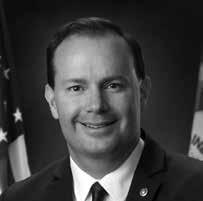
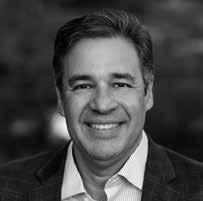
A foreign correspondent for “PBS NewsHour,” Ferguson authored the national bestseller “No Ordinary Assignment, A Memoir.” Her reporting has been recognized by two duPont Columbia silver batons, a Polk Award and an Overseas Press Club of America Peter Jennings Award, among others. Her essay about the work of a war reporter is on page 30.
Lee is the senior U.S. senator representing Utah. Also a lawyer, he clerked for future Supreme Court Justice Samuel A. Alito Jr. on the 3rd Circuit Court of Appeals and was general counsel to Utah Gov. Jon Huntsman Jr. A Republican, he serves on the Senate’s Energy and Natural Resources Committee and his commentary on public lands is on page 15.

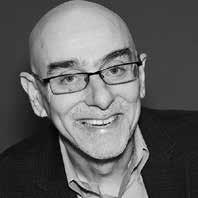
A Baltimore-based illustrator, writer and designer, Nilson’s work has been published by The Washington Post, Y Magazine, Hardie Grant U and others. In 2023, she received the Award of Excellence from Communication Arts magazine and her work was featured in 3x3 Magazine. Her illustration is featured on page 76.
Teixeira is a senior fellow at the American Enterprise Institute. A political demographer and commentator, his writing has been published in The Atlantic, The Wall Street Journal, National Review and The New York Times. An excerpt from his latest book, co-authored with John B. Judis, “Where Have All the Democrats Gone?,” is on page 62.
Labrador is Idaho’s attorney general and represented the state as a Republican in the U.S. House of Representatives for eight years beginning in 2011. He was chairman of the House Judiciary Subcommittee on Immigration and Border Security and sat on the House Natural Resources Committee. His essay on the immigration crisis is on page 68.

Paterson is a photographer based in Vancouver, British Columbia, Canada. She works with The Wall Street Journal, The New York Times, The Washington Post, Bloomberg, The Guardian and other publications and commercial clients, including Nike, Apple and Lululemon. Her photography can be seen on page 36.
6 DESERET MAGAZINE CONTRIBUTORS
JANE FERGUSON
RAÚL LABRADOR
ALANA PATERSON
MIKE LEE
RUY TEIXEIRA
LEXI NILSON
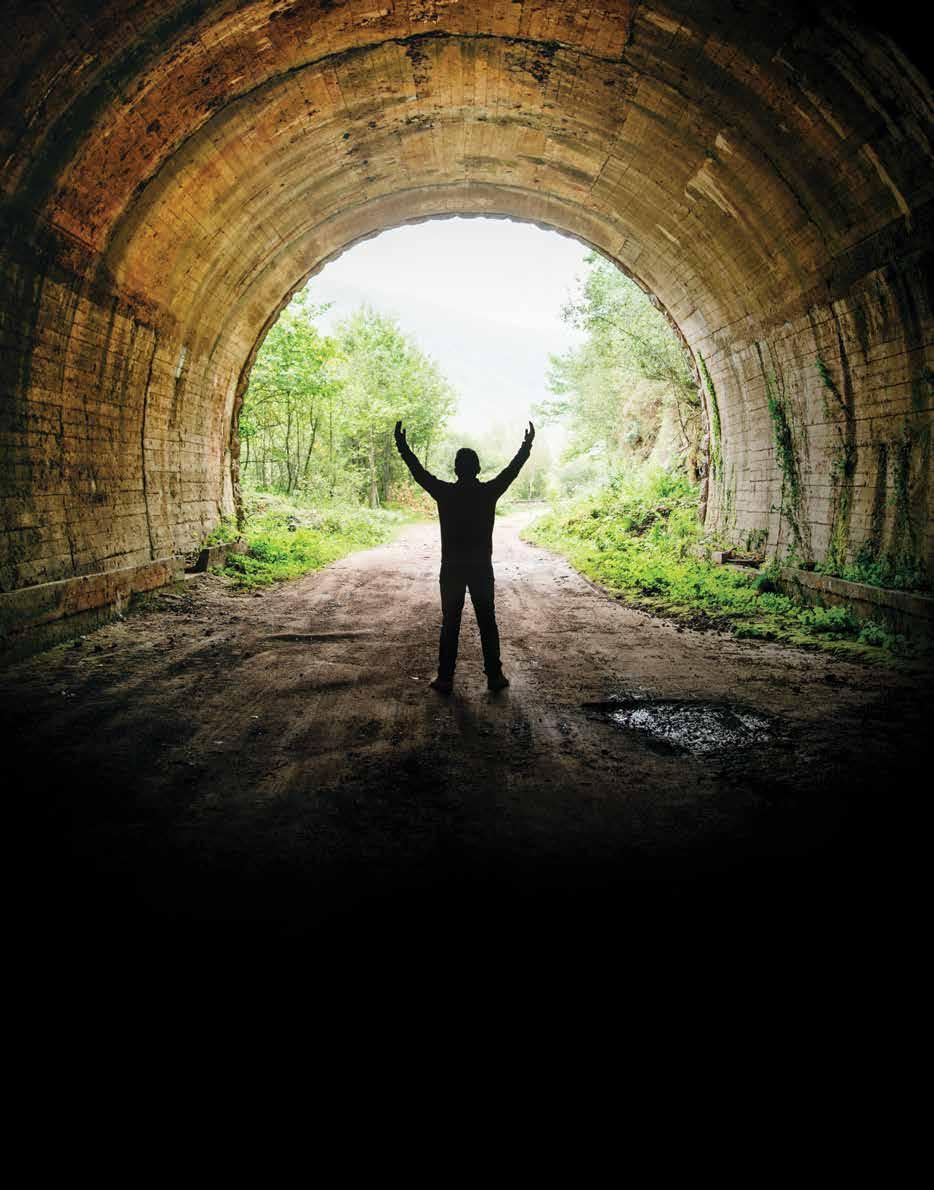
It will get brighter. OPTIMISM
EXECUTIVE EDITOR
HAL BOYD
EDITOR
JESSE HYDE
CREATIVE DIRECTOR
ERIC GILLETT
MANAGING EDITOR
MATTHEW BROWN
DEPUTY EDITOR
CHAD NIELSEN
CONTRIBUTING EDITORS
JAMES R. GARDNER, LAUREN STEELE
POLITICS EDITOR
SUZANNE BATES
EDITOR-AT-LARGE
DOUG WILKS
STAFF WRITERS
ETHAN BAUER, NATALIA GALICZA
WRITER-AT-LARGE
MICHAEL J. MOONEY
CONTRIBUTING WRITERS
LOIS M. COLLINS, KELSEY DALLAS, JENNIFER GRAHAM
ART DIRECTORS
IAN SULLIVAN, BRENNA VATERLAUS
COPY EDITORS
SARAH HARRIS, VALERIE JONES, CHRIS MILLER, HANNAH MURDOCK, TYLER NELSON
DESERET MAGAZINE (ISSN 2537-3693) COPYRIGHT © 2024 BY DESERET NEWS PUBLISHING CO. IS PUBLISHED MONTHLY EXCEPT BI-MONTHLY IN JULY/AUGUST AND JANUARY/FEBRUARY BY THE DESERET NEWS, 55 N 300 W, SUITE 400, SALT LAKE CITY, UTAH. TO SUBSCRIBE VISIT PAGES.DESERET.COM/SUBSCRIBE. PERIODICALS POSTAGE IS PAID AT SALT LAKE CITY, UTAH
POSTMASTER: PLEASE SEND ADDRESS CHANGES TO PO BOX 2220, SALT LAKE CITY, UTAH 84101.
DESERET NEWS PUBLISHING CO.
PUBLISHER
BURKE OLSEN
CHIEF FINANCIAL OFFICER
DAVID STEINBACH
VICE PRESIDENT MARKETING
DANIEL FRANCISCO
SENIOR VICE PRESIDENT SALES TRENT EYRE
VICE PRESIDENT SALES SALLY STEED
PRODUCTION MANAGER
MEGAN DONIO
OPERATIONS MANAGER
BRITTANY M C CREADY
DIRECTOR OF CIRCULATION SYLVIA HANSEN
THE DESERET NEWS’ PRINCIPAL OFFICE IS 55 N. 300 WEST, STE 400, SALT LAKE CITY, UTAH. COPYRIGHT 2024, DESERET NEWS PUBLISHING CO. ALL RIGHTS RESERVED. PRINTED IN THE USA.
DESERET
PROPOSED AS A STATE IN 1849, DESERET SPANNED FROM THE SIERRAS IN CALIFORNIA TO THE ROCKIES IN COLORADO, AND FROM THE BORDER OF MEXICO NORTH TO OREGON, IDAHO AND WYOMING. INFORMED BY OUR HERITAGE AND VALUES, DESERET MAGAZINE COVERS THE PEOPLE AND CULTURE OF THAT TERRITORY AND ITS INTERSECTION WITH THE BROADER WORLD.


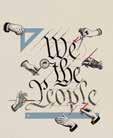


8 DESERET MAGAZINE AWARD-WINNING JOURNALISM ABOUT THE PLACE WE CALL HOME SCAN HERE TO SUBSCRIBE DESERET MAGAZINE UPC REFERENCE JULY/AUGUST 2023 PLURIBUS DISUNION HOW DID WE BECOME SO DESERET MAGAZINE UPC REFERENCE AMERICAN EDUCATION THE PATHWAY AN ODE TO THE TRAMPOLINE DESERET MAGAZINE UPC REFERENCE JUNE 2023 THE FAITH OF MIKE PENCE COLORADO RIVER TIPPING POINT? TWITTER FREE SPEECH ESCAPE UKRAINE THE FATE DESERET MAGAZINE UPC REFERENCE DESERET MAGAZINE UPC REFERENCE ABBY COX STATE WEST OF THE NAVAJO NATION
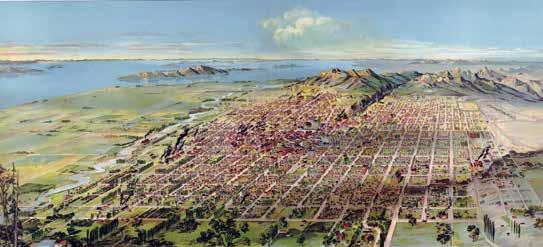
FUTURE OF THE WEST
If the Pilgrims had landed in California, the East Coast would still be a wilderness.”
That line is usually attributed to Ronald Reagan, and whether he said it or not, I often quote it (especially to rib a New Yorker) because, well, the Gipper was right. Who would push across a country if you’d already found paradise? A state that can claim the Redwoods and Yosemite, but also Tahoe and Laurel Canyon, Beverly Hills and Disneyland, the Rose Bowl and Hollywood, the Golden Gate Bridge and Pebble Beach — there’s a reason Prince Harry gave up the crown for California.
For many growing up in the West, California is the center of gravity. Families in Utah County plan their summers around trips to Disneyland. If you live on the East Bench, it might be a week in Newport. We may spend the rest of the year complaining about California — its traffic, its crime, its congestion — but on a gray day in February, “California Dreamin’” by the Mamas & the Papas might as well be the soundtrack.
And yet, there’s no denying something has changed. As Natalia Galicza reports in this month’s cover story, 800,000 people left the Golden State between 2021 and 2022.
So, what’s the matter with California?
To answer that question, Natalia drove from the southern end of the state all the way up to Butte County. She visited Los Angeles, where the homeless crisis is so bad that Skid Row now covers 50 city blocks, and to San Francisco, where downtown has become so dangerous that major retailers like Nordstrom and Whole Foods are simply closing up shop.
But the problem extends beyond the major population centers. In the Central Valley — the most productive farmland in the country — concerns about drought and climate change are pushing farmers out. In places like Butte County, the wildfire plague is what’s spurring out-migration.
To be clear, most people who live in California do not want to move, and if they can afford to stay, they will. The question is how much longer the financial costs will outweigh these growing problems, and whether the exodus that began during the pandemic will continue or recede over time.
Of course, there’s more going on in our annual State of the West issue. Sen. Mike Lee explores the debate over public lands and Idaho Attorney General Raúl Labrador offers ideas to resolve the immigration crisis at the border. Staff writer Ethan Bauer travels to Las Vegas to understand how and why gambling has taken over sports. Finally, managing editor Matthew Brown dives into the military’s role in shaping the West — for better or worse.
Ronald Reagan understood that California was more than just a place to visit, and how important the West was to the nation. He also knew that the West — outside a few coastal metropolises — doesn’t get the attention it merits in the national conversation. We believe that’s an ongoing mistake. The West’s perspectives on today’s issues are both distinct and essential. But we also know that for the world to understand who we are, it starts with understanding where we come from. I think the Gipper would agree.
JESSE HYDE
MARCH 2024 9
THE VIEW FROM HERE
“


(844) 222-1967 MINKYCOUTURE.COM


12 DESERET MAGAZINE OPENING SHOT
"PLEASURE CENTER" (ABOVE) AND "FOLLOW THE LEADER" (RIGHT) FROM THE SERIES "RANCH SIGHTINGS (WILD + DOMESTIC)." PHOTOGRAPHY BY LAUREN GRABELLE IN BIG FORK, MONTANA
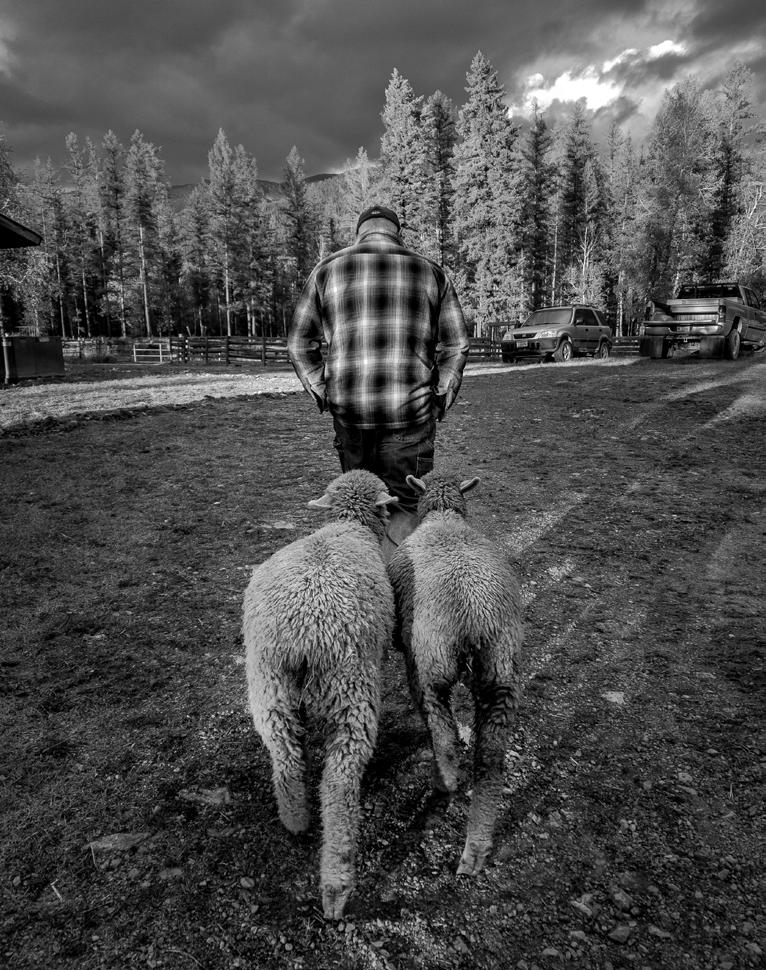
MARCH 2024 13
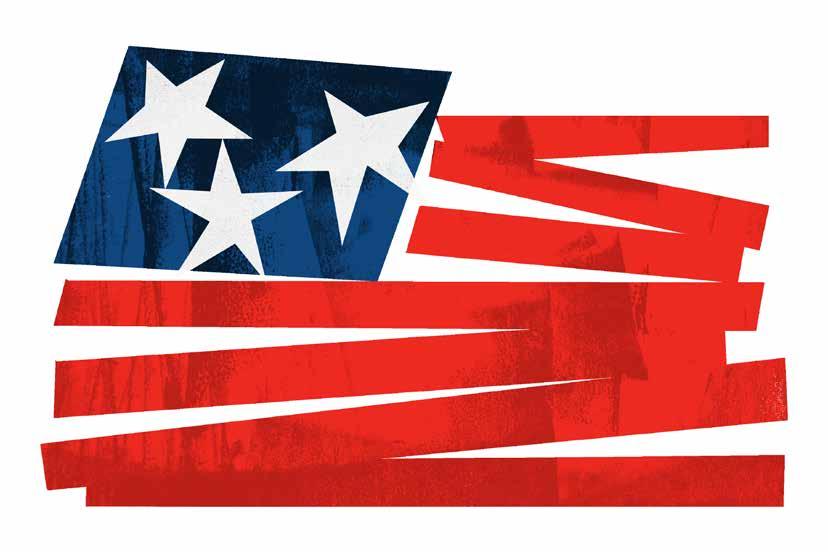

LAND GRAB
WHY THE GOVERNMENT SHOULDN’T OWN THE WEST
BY MIKE LEE
Over 175 years ago, Brigham Young and the first company of Latter-day Saints entered the Salt Lake Valley in search of land to practice their faith without interference.
Their pursuit was not unique. Much of history has depended on ordinary people’s ability to have a part of the earth they call their own: a plot of land they can have and hold, “to dress it and keep it.”
Yet, modern-day Utahns and many citizens in neighboring states find themselves singled out and excluded from this basic tenet of the American dream.
They’re excluded by a federal government whose land hoard has grown to encompass a full third of the United States. This vast federal ownership is felt particularly by those in the West. The federal government owns just 4 percent of all land in the United States east of the Rockies. But west of the Rockies, it owns more than half of the land, including almost two-thirds of all land in Utah.
It wasn’t supposed to be this way.
Section 9 of Utah’s Enabling Act stated that federally owned land within the state “shall be sold by the United States subsequent to the admission of said state into the union.”
Similar language in enabling acts for Missouri, North Dakota and Illinois has been honored. At one point, the federal government controlled over 90 percent of the land in each of those states. Not today. The federal government sold back most of that land decades ago, but Congress has yet to honor its promise to dispose of the federal land in Utah or most of the West.
The Constitution set clear limits on federal land retention. The property clause only authorizes the disposal of land, and the
enclave clause limits federal land ownership only to what is needed for “the Erection of Forts, Magazines, Arsenals, dock-Yards, and other needful Buildings.” Over time, however, the stewardship of federal lands has veered from those principles into an overbearing presence that stifles the lifeblood of local communities.
This shift culminated in 1976, when Congress passed the Federal Land Policy and Management Act. This law completely upended the federal government’s public land policy. No longer would it be the official policy of the United States government to sell back the land, entrusting it to the people. Instead, its policy would be to keep the land, in perpetuity, for itself.
In many respects, this vast federal estate is reserved for the enjoyment of the very few: an elite who want to transform the American West into picturesque tourist villages and uninhabited, but nonetheless beautiful, vistas. They like to say that federal lands are an inheritance for every American to enjoy. But the benefits these elites extol seem primarily to flow their way, while the burdens tend to fall upon the people who live close to those very lands.
The distant elites get their playgrounds in places like Aspen and Moab. They get their rustic cabins, craft breweries, artisanal coffee shops and bed-and-breakfasts.
But what do the actual inhabitants of these locales get?
They get to sell the family farm after generations of ownership because they’re told that the grazing rights their family has enjoyed for generations are now illegal. They watch their children grow up, anxious that they have no future where their families have lived for generations.
The federal government’s stranglehold on the West means our communities can’t fully benefit from the lands surrounding them. The inability to access these lands or collect property taxes stifles local economies and strains public services.
Although programs like payment in lieu of taxes are meant to compensate for these losses, Congress reliably fails to fully fund those programs, leaving our communities to bear the burden of federal land ownership without fair support.
Our immediate task is to rein in the federal government and reclaim a space for ordinary Americans to live and prosper. We must restore the Founders’ vision of localism and self-government. These principles inspired the creation of our communities and fostered the development of the greatest civilization the world has ever known.
As we navigate the future of our public lands, we must remember the individuals, families and towns that are the lifeblood of the West. The conversation must shift to a balanced approach that respects our natural heritage and the needs of local communities. It’s time to reevaluate our stance on federal land management and work toward solutions that uphold the spirit of our Constitution while promoting the well-being of families and the land they call home.
MARCH 2024 15 COMMENTARY
MIKE LEE HAS BEEN A U.S. SENATOR REPRESENTING UTAH SINCE 2011.
COUCH BOUND
WHY AMERICANS WANT TO TALK IT OUT
AMERICANS HAVE BEEN GOING THROUGH IT. And more than ever before, they want to talk about it. Many find comfort and hope in getting outdoors, being physically active, eating right, sleeping better, engaging in their community or talking to an ecclesiastical leader, but for those who benefit from professional help, the stigma seems to be gone. People brag about getting therapy on dating profiles and social media. They download smartphone apps that promise to help with anxiety, depression, grief or PTSD. Demand is increasing so fast that U.S. senators on both sides of the aisle want to ensure there are enough qualified providers to meet it. How can therapy change America's mental health?
ARIANA DONALDS
1 IN 5 AMERICANS
That’s how many are in therapy now, including about 10 percent more women than men, according to the Centers for Disease Control and Prevention, and more young people. A recent study from the American Psychological Association found that 35 percent of millennials and 37 percent of Gen Z have received treatment from a mental health professional, compared with just 26 percent of Gen Xers and 22 percent of baby boomers.
WHAT IS IT ANYWAY?
Psychologytoday.com defines psychotherapy as “a form of treatment aimed at relieving emotional distress and mental health problems. Provided by any of a variety of trained professionals — psychiatrists, psychologists, social workers or licensed counselors — it involves examining and gaining insight into life choices and difficulties faced by individuals, couples or families.”
Talk therapy is often used alongside psychotropic medication.

A DISMAL TOP 5
Depression, anxiety, relationships, addiction and sleep issues are the

biggest factors driving people to seek therapy. But studies also link these issues to news headlines. A 2018 APA survey found that 75 percent of respondents aged 15-21 said that mass shootings are a significant source
of stress. They were also concerned about immigration policies like deportation and family separation (57 percent to 45 percent) and sexual harassment and assault (53 percent to 39 percent).
16 DESERET MAGAZINE THE BREAKDOWN
REAL TALK
Psychoanalysis is the talking cure you see in old movies, involving long years of committed therapy with a certain provider, delving into past experiences and unresolved emotions to understand “the influence of such unconscious forces as repressed impulses, internal conflicts and childhood traumas on the mental life and adjustment of the individual,” according to the APA. It has been effectively used to treat depression, anxiety and borderline personality disorder, among others.

“IT IS STILL LARGELY AN UNREGULATED FIELD. THERE’S LICENSING FOR PSYCHOLOGISTS, PSYCHIATRISTS, SOCIAL WORKERS, LICENSED COUNSELORS. BUT THE TERMS PSYCHOTHERAPIST AND COUNSELOR ARE NOT LEGALLY REGULATED IN ANY STATE.”
JOHN C. NORCROSS, CLINICAL PSYCHOLOGIST FROM THE UNIVERSITY OF SCRANTON WHO FOR 45 YEARS HAS RESEARCHED THERAPY’S EFFECTS ON AMERICANS
PROBLEM SOLVING
Cognitive-behavioral therapy, or CBT, is focused on practical tools for coping with emotional issues. Patients learn to recognize faulty thought patterns (e.g., this failed so it will never work) and replace them (this has worked before, it just didn’t work this time). They also learn to better understand the behaviors of others and practice mindfulness to seek calm in the storm. CBT can help with a broad range of issues, like chronic pain, ADHD, eating disorders and even schizophrenia.
10 SESSIONS
That’s about all it takes for a short-term therapy cycle these days. Fifty years ago, the same results could require up to 40 sessions. There are now reliable treatments for problems that were once difficult to handle, like trauma, panic disorder and
obsessive-compulsive disorder. Not only is this more cost-efficient, but the decreased time commitment makes it easier for patients to follow through.
10,000 SHORT
That’s the national deficit in mental health care providers forecast for 2025, according to the Department of Health and Human Services. Forty-seven percent of Americans already live in a “mental health workforce shortage area,” according to KFF, a health policy research group. Texas, California and Florida face the gravest shortfalls; Nevada and Arizona rank 12th and 13th, respectively, while Idaho ranks 34th and Utah 35th. Telemedicine may help, and some communities are even training barbers to pitch in.
 I, ROBOT
I, ROBOT
Some are excited to incorporate artificial intelligence into mental health care, as a complement to trained professionals. Skeptics may cringe, but the APA believes AI can automate administrative tasks, help train new therapists and use chatbots to streamline treatment, making therapy “more accessible and less expensive.” AI may even start listening in on sessions, tracking symptoms and highlighting themes for practitioners to review.
8 YEARS A POSTGRAD
Training for therapists varies, as do their titles. A counselor or licensed clinical social worker might start with a master’s program in psychology, marriage and family therapy or counseling, followed by three to five years of practice and a successful licensing exam. Psychiatrists can prescribe medication, so they must complete four years of med school and four more in residency.
MARCH 2024 17
ILLUSTRATION BY ANDR É DA LOBA
RAW DEAL
SHOULD AMERICANS SUBSIDIZE GREEN ENERGY?

AS THE PACE AND SCALE of natural disasters increase and scientists continue to sound the alarm about the warming climate, Democrats are calling for grand reinventions of America’s energy industry. Through programs like the Green New Deal, they aim to increase subsidies for renewable energy sources like wind, solar and hydroelectric to avoid the most catastrophic effects of climate change. Opponents and GOP leaders deride that approach as an economic wrecking ball. While some still dismiss the scientific consensus on human-caused warming, even Republicans who prioritize this issue fear that building a new industry through a government expansion is the wrong move for America.
M
EGAN FELDMAN BETTENCOURT
18 DESERET MAGAZINE POINT / COUNTERPOINT
AN EXISTENTIAL THREAT TRUST THE MARKET
CLIMATE CHANGE is an existential threat to life as we know it. Humanity has never faced a more urgent task than the race to reduce the consumption of fossil fuels in order to stem the catastrophic rise in worldwide atmospheric temperatures, and that requires a dramatic shift in how we think about the economy. The only way to quickly replace oil and gas with renewable energy sources is through government action as sweeping and transformative as the country’s responses to other cataclysmic events, such as the Great Depression and World War II.
Subsidies are not a new idea. The federal government has invested in the development and distribution of new energy sources since the start of the republic. A Yale study found that the oil and gas industry received more government funding in inflation-adjusted taxpayer dollars at its early stages of development than green energy does today. The U.S. still spends billions of dollars each year on fossil fuel subsidies, money that should now be redirected to renewable energy sources.
“We need to phase out fossil fuels completely,” says Martha Molfetas, a senior fellow at the think tank New America. “Renewable subsidies will increase our energy security, reduce air pollution and avoid the negative water and soil impacts that fossil fuels have caused over the past 100 years.”
Tax incentives like those included in the Inflation Reduction Act are a form of support that can also help renewable energy developers to get up and running faster and at a lower cost. This in turn can help consumers to make costly initial investments in retrofitting their homes, such as installing solar panels and heat pumps. Like any government investment in new industries, this will result in more people entering the renewables market, increasing the use of these technologies, creating jobs and growing the economy.
TAX CREDITS and other subsidies mean large expenditures of money. And that money must come from raising taxes, increasing the federal debt, or both. “Green energy subsidies will be financed with still more government debt,” says Jonathan Lesser, an adjunct fellow at the Manhattan Institute, a conservative think tank. “In another five years, the interest on debt could be the largest item in the government budget.”
Not only will subsidies hinder private investment in new energy sources, they won’t even make renewable energies more affordable. According to The Wall Street Journal editorial board, “the government-forced green energy transition” has driven up prices for wind and solar manufacturing parts by artificially increasing demand — and those costs will be passed on to consumers.
Instead, the U.S. should unleash the power of the free market to reward innovation. Eliminating dependence on government would incentivize clean energy technology leaders to compete for private capital and market share by coming up with better solutions at lower costs. “Two wrongs don’t make a right,” Lesser says, acknowledging the government’s historical support of oil and gas. “The idea that you can subsidize your way to economic growth is a fantasy.”
Another fantasy is the idea that we can reach net zero by replacing fossil fuels with wind and solar alone. Nuclear should be part of the mix, as it is in countries like France and Finland. Small modular nuclear plants could be a meaningful part of a diverse energy mix that helps us decarbonize the economy — especially if industry leaders are incentivized by the market to keep creating cleaner, safer forms of nuclear power.
MARCH 2024 19 ILLUSTRATION BY JEAN-FRANCOIS PODEVIN
MARRIAGE MASTERY
FAITH, UTAH COUNTY AND THE SECRET TO A HAPPY MARRIAGE
BY BRAD WILCOX
Everyone wants to know the surefire secret to success at love and marriage. That’s why the local Barnes & Noble aisle on relationships is packed with books full of tips on how to win at love. One of the better offerings in this department is psychologist John Gottman’s bestselling book, “The Relationship Cure: A 5-Step Guide to Strengthening Your Marriage, Family, and Friendships.”
The book is based in part on wisdom Gottman gleaned from observing hundreds of couples at his “Love Lab” at the University of Washington in Seattle to determine what goes into strong and stable relationships. Based on his research, he advises couples to do things like steering clear of what he calls the “Four Horsemen of the Apocalypse”: stonewalling, defensiveness, criticism and contempt. There’s a lot to learn from his research.
However, Gottman is focusing on what might be called the “microclimate” of an individual marriage — the discrete interactions that make for a good or bad
relationship. As a sociologist, I am interested in studying the wider contexts, the “macroclimates,” in which strong and stable marriages thrive. Why is it that the picture-perfect Laurelhurst community near his Love Lab has lots of stable fami-
THE QUALITY AND STABILITY OF MARRIAGES ACROSS THE LAND ALSO MATTER FOR THAT UNIVERSAL QUEST: THE PURSUIT OF HAPPINESS.
lies and a Seattle neighborhood just several miles south of his lab is dominated by single parents? And what explains why marriage is strong in some communities and weak in others across the nation?
Part of the sociological answer to these questions is about money. Marriage tends
to be stronger in neighborhoods where the cash flow is better, neighborhoods like Laurelhurst where there is less poverty and more affluence. Higher-income neighborhoods are dominated by two-parent families — about 80 percent of the families with children. Lower-income neighborhoods, by contrast, are places where almost 50 percent of the families are headed by single parents. That’s in part because financial stress and unemployment — especially on the part of men — are major drivers of relationship discord and divorce.
BUT MONEY ISN’T the whole story. Culture also matters. When we look at counties across the United States, one cultural factor shaping family life zooms into focus: faith.
Consider, for instance, Utah County, Utah, which has the highest proportion of married families of any midsize-to-large county (more than 50,000 people) in America. In recent years, the county has prospered in part because it has attracted
20 DESERET MAGAZINE MODERN FAMILY

MARCH 2024 21 ILLUSTRATION BY
SANDRA DIONISI
FAITH IS THE STRONGEST PREDICTOR OF MARITAL QUALITY WHEN COMPARED TO OTHER FACTORS LIKE IDEOLOGY, EDUCATION, RACE AND INCOME.
a number of California companies — from Adobe to Intel — and midwifed a number of startups seeking out its highly motivated workforce and favorable tax burden. Still, those living there are not in the upper echelons of America when it comes to income: The median household income was around $77,000 in 2021, which positions it solidly in a middle-class bracket. What really makes this county stand out is the faith factor. The population is predominantly members of The Church of Jesus Christ of Latter-day Saints.
But Utah County is not an outlier. When we look at the midsize-to-large counties with the most children living in a married family, the most religious counties in the country are disproportionately likely to make the list. Utah County is No. 1 on this family indicator, and the second most religious county in America — measured by the share of adults who report a religious affiliation. But outside of Utah, places like Williamson County in Tennessee, which has lots of churchgoing evangelical Protestants, and Geauga County in Ohio, which is 20 percent Amish, also land on this list. Of these top 10 counties, half are among the most religious places in the nation (in the top 25 percent for religious affiliation in the nation). Clearly, then, religion is one factor at the county level when it comes to family stability.
IF WE LOOK above and beyond neighborhoods and counties, nationally representative surveys identify four groups that stand out for being masters of marriage — those who are most likely to get married, steer clear of divorce court and forge reasonably happy unions.
The first group is the Faithful. I use the term loosely to refer to those Americans who attend worship services several times a month or more. Their ties to their local religious communities endow their marriages and family lives with deep spiritual significance.
Fellow adherents can provide practical, social, emotional and even financial support when called upon. They are most likely
to believe, on principle, that the institution of marriage is good for the well-being of kids, communities and the country.
The second group is the Conservatives. This group embraces classic American middle-class, or what scholars call “bourgeois,” values — like education, hard work, financial success and personal responsibility — as well as “traditional” values like the importance of religion, marriage, sexual fidelity in marriage and the idea that men and women are inherently different. Today, for Conservatives who are and are not religious, their commitments to more traditional beliefs about family, sex and gender are also shaped by conservative media, public intellectuals and friends.
The third group is Strivers. This group also embraces “bourgeois” values and tend to more likely take the long-term view and embrace delayed gratification. Strivers largely dominate the professions, the business world, the universities and the media. Even though many hold fashionably liberal views about family matters — including politically correct attitudes about family diversity and single motherhood — they do not put these views into practice in their own private lives.
The fourth group is Asian Americans, who also tend to embrace Striver-style values and “are the highest-income, best-educated, and fastest-growing racial group in the United States,” as Bruce Drake from Pew Research Center pointed out.
Asian Americans’ devotion to Eastern-style traditional family values is also a big part of their American success story. Their orientation to marriage is rooted in a combination of principle and prudence: Their traditions — be they Confucian, Hindu or Muslim — push them in a family-first direction. And they recognize that stable families give their kids a big head start in their pursuit of the American dream.
STATISTICS IN THE General Social Survey show that these groups are more inclined to marry and stay married. That kind of stability is important, but the quality of married
22 DESERET MAGAZINE
life also matters. After all, a stable marriage is not as valuable for the children or for the adults if the parents are miserable. So, how do these four groups fare when it comes not just to the stability of their marriages but also to the quality of their unions?
Strivers are happier husbands and wives. College-educated husbands and wives are about 5 percentage points more likely to report that they are “very happy” in their marriages, compared to married adults without a college degree. In fact, higher education is the second most powerful predictor of marital quality when we account for key sociodemographic factors in our analyses.
For the Faithful, meanwhile, the data is especially clear. Husbands and wives who attend religious services frequently are about 6 percentage points more likely to report they are “very happy” in their marriages, compared to those who attend sporadically or not at all. In fact, the GSS found that faith is the strongest predictor of marital quality when compared to other factors like ideology, education, race and income.
Conservatives are also happier in their marriages. They enjoy a 6-percentage-point advantage over moderates and a 5-percentage-point advantage over liberals. More fine-grained analyses indicate that the happiest husbands and wives hail from the “very conservative” camp.
The Asian advantage is more modest when it comes to marital quality, at least as Americans. They are only a few percentage points more likely to be in the happiest
FAMILY STRUCTURE WAS THE BIGGEST FACTOR IN PREDICTING POOR KIDS’ ODDS OF REALIZING THE AMERICAN DREAM IN COMMUNITIES ACROSS THE COUNTRY.
wives and husbands club, compared to married African Americans and Hispanics, and they are not happier than married white people. In fact, it is precisely because Asian Americans are more likely to pursue family stability that they are more willing than other Americans to put up with a difficult marriage.
STABILITY AND HAPPINESS in a marriage are not just important for individual couples — they also have implications for the country at large. That’s in part because they can also profoundly impact the lives of the children that come into a couple’s life, and those children represent the future health and prosperity of the country.
When Harvard economist Raj Chetty and his colleagues looked at the factors driving economic mobility for poor children — i.e., their capacity to go from rags in childhood to riches in adulthood — they compared results from one local community to another, in locations across the United States. They found that “the strongest and most robust predictor (of children’s economic mobility) is the fraction of children (in the community) with single parents.” Not income inequality. Not race. Not school quality. Family structure was the biggest factor in predicting poor kids’ odds of realizing the American dream in communities across the country.
The quality and stability of marriages across the land also matter for that universal quest: the pursuit of happiness. Consider
the growing happiness divide in American life. Educated and affluent people have seen their happiness levels dip a bit in recent years, but the “happiness of lower-SES (socioeconomic status) people” has decreased dramatically, according to psychologist Jean Twenge. This means there’s a growing happiness gap between more privileged and less privileged Americans. Guess what is one of the biggest factors explaining our country’s class divide in happiness?
Marriage.
It turns out that the marriage rate is in free fall among our country’s poor and working class. This translates into “less happiness among those with lower SES,” Twenge observed. By contrast, marriage is in much better shape among affluent Americans, which helps explain why they are doing much better in the happiness department.
Research like this tells us that what happens in our hearts and homes doesn’t just matter for our own well-being, it matters for the welfare of our children and country. So, if you’re married, for your own sake — and, indeed, the sake of our civilization — I urge you to find new ways to honor your commitment to love and cherish your spouse and any children you may have all the days of your life.
ADAPTED FROM THE BOOK “GET MARRIED: WHY AMERICANS MUST DEFY THE ELITES, FORGE STRONG FAMILIES, AND SAVE CIVILIZATION” BY BRAD WILCOX.
COPYRIGHT © 2024 BY W. BRADFORD WILCOX. RE -
PRINTED BY PERMISSION OF BROADSIDE BOOKS, AN IMPRINT OF HARPERCOLLINS PUBLISHERS.
MARCH 2024 23
SHELL-SHOCKED
MILITARY INVESTMENT SHAPED THE WEST — THEN CAME THE FALLOUT
BY MATTHEW BROWN
As Tina Cordova perused pages of her hometown paper, Alamogordo Daily News, she came across a letter to the editor sent in from Fred Tyler, a fellow Tularosa Basin native who had returned to New Mexico after 30 years away. “I’m back now and everybody’s sick and dying, and my mom just died,” Cordova recalls reading. “I wonder when we’re going to hold our government accountable for the damage they did to us?”
That question had been festering for years inside Cordova, who is the fourth generation of her family to get cancer since the Trinity test in 1945 — the world’s first nuclear bomb — contaminated the air, soil and groundwater of her remote rural community just 65 miles from the detonation site. She kept a file of newspaper clippings on downwinders from other states who claimed their cancer came from nuclear weapons testing in southern Nevada. After reading Tyler’s letter that day in 2005, she called him and shared the deaths and health problems her family suffered since Trinity.
“We are hard-working, tax-paying patriots,” she says. “My grandfather was killed in Germany (during World War II) and is
buried in Belgium. My family has given a hell of a lot to this. I don’t know what more they want from us. But it’s easy for them to look away from us.” Together, Cordova and Tyler founded the Tularosa Basin Downwinders Consortium that same year, spending the past 18 years fighting for
THE STRUGGLE TO ADDRESS THE HARM FROM NUCLEAR WEAPONS TESTING IS PROBABLY THE HIGHEST-STAKES EXAMPLE OF THE COMPLICATED RELATIONSHIP BETWEEN THE MILITARY AND THE WEST.
generational downwinders and uranium miners to not just get individual payments of up to $100,000, an amount mandated by Congress in 1990 for victims, but also health care for the illnesses they continue to endure.
For nearly two decades, the consortium
has gathered oral histories of families of survivors. They have evidence that military and government officials dismissed concerns expressed by a few scientists with the Manhattan Project of radioactive fallout poisoning people and the environment. They have proof that no warnings were given to residents living near the test site. Not that it would have mattered much, though, since the fallout reached far and wide. New research released last year by Princeton University’s Program on Science and Global Security shows the contamination from the Trinity blast spread beyond New Mexico to 45 other states, further strengthening the consortium’s appeal to extend a 34-year-old federal program to compensate downwinders in Idaho, Montana, Colorado, Nevada, Arizona, Utah and Guam for harm caused by the radioactive fallout.
The ongoing, difficult struggle to address the harm from nuclear weapons testing is probably the highest-stakes example of the complicated relationship that has evolved over the past two centuries between the military and the West. While the federal government is constitutionally bound to defend the country, the people and the land
24 DESERET MAGAZINE THE WEST

MARCH 2024 25 ILLUSTRATION BY JACOB PLEITEZ
THE WEST
they live on have been hurt in achieving that mission. The conflict is particularly profound in states where the positive impact of a military installation on a local community — infrastructure, jobs, growth, tax revenue, social structures — can obscure the risks of hitching a local economy to a government-operated military installation. That’s the rub throughout most of the West, which was historically explored, occupied, shaped, paved and built by government largesse and the military. But the communities that rely on the economic stability and infrastructure that the military has provided are often the same communities later wracked with consequences that strip the land, water, air and people of their health. It’s a tension that has plagued past generations, and one that will become more fraught as those living in the West continue to weigh the accumulating costs against the economic benefits of contributing to their nation’s defense.
The Senate and House negotiated a defense spending bill that could extend the compensation program Cordova and the consortium are fighting for before it expires in June. But the downwinders, who are the most acute victims, represent a fraction of the thousands of Americans living within the reach of at least 38 military bases in the West that are also EPA Superfund sites — an indication that just containing the contamination, let alone cleaning it up, is billions of dollars and many years away.
Mitigating the damage done through decades of military use of Western lands — and dealing with the dilemma of curbing future damage — has been agonizingly slow for people like Cordova. That will likely not change in the near future. “At the end of the day, I go back to this famous dictum of Immanuel Kant: ‘Out of the crooked timber of humanity, no straight thing was ever made,’” says Stanford University history professor David Kennedy, who co-edited the book “World War II and the West it Wrought.” “This is the world we live in. There are dilemmas that don’t yield easy solutions. And this is one of them.”
THE U.S. MILITARY has had a presence in the American West for over two centuries, since Lewis and Clark’s Corps of Discovery began its famous expedition into the Northwest in 1804. But that presence expanded dramatically as the nation readied itself for World War II
Beginning in October 1940, President Franklin D. Roosevelt began withdrawing huge tracts of public lands in the Great Basin, Mojave, Sonoran and Chihuahuan deserts by executive orders for defense purposes. Among those withdrawals were 1.2 million acres of the Alamogordo range, where the Trinity Test would take place. Through these executive orders, land condemnation and purchases, the military occupied New Mexico’s isolated Pajarito Plateau, where scientists developed the atom bomb at what is now called Los Alamos National Laboratory. All but seven of the more than two dozen military bases and depots still operating in the Intermountain West were either established or significantly expanded during World War II. By the stroke of a pen, the Department of Defense became a major landlord in the West — controlling more than 17.5 million acres in 10 Western states — and making New Mexico, California, Nevada, Arizona, Alaska and Utah the top six military states in the country today in terms of acreage. “In Utah, the (Department of Defense’s) total acreage exceeds the combined acreage of the ‘Mighty 5’ national parks (Arches, Bryce, Canyonlands, Capitol Reef and Zion) for which the Beehive State is renowned around the world,” University of Pennsylvania historian Jared Farmer writes in an article published in “World War II and the West it Wrought.”
A federal takeover of Western terrain would appear to go against the region’s ethos of resisting government encroachment of the land. But political leaders recognized the economic benefits of the military moving in and privately welcomed the armed forces despite constituent ranchers and farmers complaining about government intrusion. “Out of one side of his mouth he defended the customary rights
of freedom-loving ranchers against the tyranny of big government; out of the other he sweet-talked the military to make sure Nevada got as many bases and government jobs as possible,” Farmer writes of U.S. Sen. Pat McCarran of Nevada, a Democrat who represented Nevada from 1933 to 1954. “In similar fashion, Utah’s elected leaders welcomed the War Department even as they castigated the Interior Department” over other land management disputes.
It wasn’t just political lobbying that prompted the armed forces to look West. The late economic historian Gerald Nash concludes that military leaders were attracted to the sparsely populated, undeveloped expanse of the West because it provided “an inviting milieu for technological innovation and experimentation” with weapons, aircraft and other defense systems. Open spaces were soon spoken for and molded not by private developers, but by the federal government.
In the Cold War era, the government continued to spend, funneling more than $100 billion into Western military installations between 1945 and 1973, according to Nash. The ongoing investment resulted in a new infrastructure of roads, utilities, hospitals and schools to support the growing armed forces presence. For civilians, the lure of the West shifted from wide-open spaces to high-paying jobs with military contractors in electronics, aerospace, communications, engineering and computing. “Military spending rather than market conditions determined the locations of high-tech industries,” Nash says. But changing geopolitics and concerns over deficit spending would eventually curb the downrush of federal funds and force local officials to rethink their economic strategy.
IN THE EARLY 1990s, Mike Leavitt was in his first term as Utah’s governor when local government, business and retired military leaders invited him for dinner at one of their homes in Layton and a meeting on the fate of Hill Air Force Base and other Defense Department assets in the state. Congress had authorized a Base
26 DESERET MAGAZINE
Realignment and Closure Commission to streamline defense spending in the wake of the Soviet Union’s collapse. BRAC outlined three rounds of cutbacks nationwide totaling $14 billion. Utah escaped the 1991 round. But for the next rounds in 1993 and 1995, the state was on notice that Hill Air Force Base, Defense Depot Ogden, Tooele Army Depot and Dugway Proving Ground were on the chopping block. “It was kind of all hands on deck to come up with a way to respond,” Leavitt, a former governor and Bush administration cabinet member, recalls of the meeting.
Utah wasn’t alone. BRAC jolted neighboring states to make their case to the commission that their beloved military bases were not only essential to the nation’s defense, but also to the survival of their local economies. New Mexico successfully made its case for Cannon Air Force Base, which, along with nearby Melrose Air Force Range, provides 6,413 jobs and more than $400 million in wages and salaries in the small town of Clovis, near the Texas border.
After those three rounds, Utah lost the Ogden depot and part of the Tooele installation, which eliminated a $240 million payroll going to 6,368 employees from those local economies. The Ogden installation was eventually turned into an industrial park and the military truck maintenance plant in Tooele was sold to a Detroit diesel engine manufacturer. But economists say the BRAC process should have been a wake-up call to all state and local leaders about the risk of relying too heavily on defense spending. “If the money keeps flowing, everything can kind of work. But if the money goes away, it’s not like the past history of that money has changed the fortunes of these places,” says Taylor Jawarski, an associate professor of economics at the University of Colorado Boulder.
State officials work year-round to not just increase the defense dollars coming in, but to attract industry adjacent to the mission of the armed forces in hopes of offsetting any economic disruption caused by a military installation scaling back or closing. In New
Mexico, where defense jobs total 18,000 — the state’s 17th largest employer — and defense-related jobs total 52,000, economic developers have leveraged that impact to address education, housing, health care, child care and income tax exemptions to make their communities more attractive to active-duty enlistees and veterans, who can land lucrative jobs at the defense-related research labs or other local businesses after they retire. “A veteran’s income is approximately 164 percent of a nonveteran. So, one of the benefits to creating a pro-military environment is that veterans stay,” spending their incomes locally, says Rich Glover, director of the state’s Office of Military Planning.
BY THE STROKE OF A PEN, THE DEPARTMENT OF DEFENSE BECAME A MAJOR LANDLORD IN THE WEST — CONTROLLING MORE THAN 17.5 MILLION ACRES IN 10 WESTERN STATES.
by playing up its Intercontinental Ballistic Missile maintenance mission and sprawling test and training range neighboring Dugway Proving Ground in the west desert, preserving over 22,000 jobs. Since that time, the state’s congressional delegation has shored up Hill’s future by expanding that base’s test and training range to 2.3 million acres and making the base headquarters for the Air Force’s Sentinel program, a $100 billion initiative to upgrade the nation’s ground-based nuclear missile system.
The program is projected to generate 2,500 jobs to the northern Utah communities surrounding the base. But those taking those jobs will be working and living in an area that has been an EPA Superfund site since 1987 and will remain under that status for at least 50 more years as the Air Force regularly samples the air in residents’ homes for gasses emitted from polluted groundwater, poisoned by decades of chemicals and waste from aircraft maintenance.
Arizona, home to seven Army, Marine and Air Force installations, has set its sights overseas for opportunities that complement its long-standing military presence. The state’s Defense and Industry Coalition recently inked a deal with Ukraine offering defense-related industrial and research resources to rebuild that nation while it’s still in conflict with Russia. And, in Colorado Springs, where the military accounts for 44 percent of the community’s economic activity, officials last year secured the headquarters for U.S. Space Command, which is responsible for providing satellite-based services to the U.S. military and protecting those assets from foreign threats.
While Utah lost some assets through BRAC, state and local boosters saved Hill
THE WEST, WHERE half of the nation’s 20 nuclear weapons facilities are located, hasn’t always been so welcoming to that distinction. In the early 1980s, a coalition of religious leaders, peace advocates and ranchers halted the MX missile program, which would have based 550 nuclear missiles in the Great Basin straddling Utah and Nevada. Public opposition to the idea of putting a bullseye on western Utah in a nuclear conflict grew loud, and the death knell for MX sounded when The Church of Jesus Christ of Latter-day Saints issued a press release on May 5, 1981, from its Salt Lake City headquarters, directly opposing nuclear war and the environmental damage that construction of the missile system would cause to the area and its people.
“Our fathers came to the western area to establish a base from which to carry the gospel of peace to the people of the earth,” the statement from the church’s governing First Presidency concluded. “It is ironic, and a denial of the very essence of that gospel, that in this same general area there should be constructed a mammoth
MARCH 2024 27
weapons system potentially capable of destroying much of civilization.”
Five months later, the Reagan administration scrapped the MX Missile program completely, realizing that without backing from the church’s leadership, gaining public support for the missile basing system would be unattainable, writes former West Point historian and retired Lt. Col. Sherman L. Fleek in the book “The Mormon Military Experience.”
Fittingly, the MX rejection coincided with mounting concern and evidence of adverse health effects from radioactive fallout through the government’s nuclear weapons testing in southern Nevada during the 1950s. Residents had been proud to play a part in staying a step ahead of the Soviets in a global arms race. And there were huge economic benefits to hundreds of thousands of people coming to Las Vegas, where they would live while working at the test site 65 miles to the north. “There was a tradition of people in the West embracing and benefiting greatly from huge federal projects,” says Andy Kirk, a University of Nevada at Las Vegas history professor. “This was just another huge federal project that was going to bring jobs and money.”
Kirk, a principal investigator for the Nevada Test Site Oral History Project, explains that pride and excitement turned to worry in the late 1950s and early 1960s, as those living downwind of the testing in areas of Nevada, Arizona and Utah, along with uranium miners digging up the radioactive uranium for the bombs, reported unusually high rates of illness and death suffered by people and livestock. By the late 1970s, victims mobilized to bring their case to Congress and the courts.
“We liked to play under the trees and shake this (radioactive) fallout onto our heads and our bodies, thinking that we were playing in the snow. Then I would go home and eat,” Gloria Gregerson shared at a southern Utah town meeting convened by Utah Republican Sen. Orrin Hatch in 1979. As a teen, Gregerson developed ovarian, stomach and skin cancer, as well
as leukemia. When she died in 1983 at age 42, she was among 1,100 plaintiffs who had sued the government for negligence in not disclosing the risks of the radioactive fallout from the testing.
The downwinders eventually lost their case against the government, as did a group of sheep ranchers, who blamed nuclear testing for the death and deformities of livestock in southern Utah. But Congress couldn’t ignore the press coverage of the trials, congressional hearings and government reports like “The Forgotten Guinea Pigs,” backing up allegations that the officials had misled residents. Elected leaders responded with the 1990 Radiation Exposure Compensation Act to compensate those harmed.
“I UNDERSTAND GOVERNMENT IS BIG INDUSTRY IN NEW MEXICO. BUT WE END UP BEING HOSTAGE TO THESE BIG MILITARY CONTRACTORS.”
Thirty-four years later, victims are still relying on the Radiation Exposure Compensation Act, which has doled out $2.6 billion in reparations to downwinders to date. For Cordova and those within the consortium, it’s a touchstone of hope that expansion for reparations is possible. In December, Congress finally voted on a defense spending bill that included the fate of RECA. But Cordova’s 20-year pursuit was dashed. Republican House leaders demanded the program’s expansion be eliminated in order to pass the 2024 National Defense Authorization Act. Instead of the consortium winning payments up to $100,000 and health care coverage for victims, it came away with nothing.
Press releases coming from New Mexico’s congressional delegation were a mix of disappointment for their state’s downwinders
not qualifying for RECA payments and pride for the billions allocated that will fund military installations and private contractors to generate an estimated $14 billion in economic activity in the state — an apt parallel to the generations-long dilemma of what the real cost-benefit ratio of the military’s presence in the West is. New Mexico Congresswoman Teresa Leger Fernandez, a Democrat, decried GOP House leadership’s decision to drop the compensation expansion as “morally bankrupt.” She then explained her own vote: “I supported the final version of the bipartisan bill in spite of this disgraceful omission because it secures investments in our national defense and service members — including those serving throughout New Mexico.”
Cordova doesn’t fault the state’s congressional leaders for supporting the defense package, despite it leaving the downwinders empty-handed. She understands how important the military-industrial complex is to the state’s economy. As the owner of a roofing company, she has refused to do business with local military bases or government contractors since 2005. It’s cost her. But she doesn’t expect others who support her cause to make the same sacrifice. “We have found other places to invest, but for many, many people their only option for making a living is to work for the government. I understand government is big industry in New Mexico,” Cordova acknowledges. “But we end up being hostage to these big military contractors.” It’s difficult to see how much money is being pumped into and out of the economy to maintain a military-industrial complex, without any of that money coming back to keep the land and people who make it all possible healthy. Cordova continues to work with Congress to extend the expiration date of the compensation program. She hopes that one day there will be an understanding, from the top down, that investing in the defense industry and appropriations to clean up and correct the problems that spending can create are not mutually exclusive. “We’ve got to get people to understand that these are closely linked.”
28 DESERET MAGAZINE THE WEST

THE LAST WAR REPORTER
WE USED TO TRUST
REPORTERS IN THE FIELD.
WHAT HAPPENED?
BY JANE FERGUSON
“
Don’t call yourself a war reporter.”
In a crisp blue suit and enormous corner office, an executive at a news network I once worked for scolded me as he leaned back in his chair and explained: The term doesn’t really exist as a job title. “It’s foreign correspondent.”
It was 2012 and I had just returned from an assignment in Syria as revolution tumbled into all-out war. I was still teetering back into office life after being smuggled into a rebel-held area of Syria, alone, where I filmed and documented the Bashar al-Assad regime’s crackdown on his people. It had been only 48 hours since I trudged across the border to Lebanon on foot, evading armed men to escape in the middle of the night, certain I was about to be shot in the back. Now I was facing a man in a suit. This was something of a debrief with management.
He was technically correct about what I called myself. Referring to oneself as a war reporter was not really the done thing. It was something looked upon as cringy, self-aggrandizing and only articulated by the naïve: those of us still filled with romantic notions of Martha Gellhorn and Ernest Hemingway holed up together in a battered
hotel in 1930s Madrid covering the Spanish Civil War.
In that office, still in my 20s, I sat in quiet acquiescence. “Foreign correspondent” is the umbrella term for anyone reporting overseas from the publication or outlet’s home country. The reason the term “war correspondent” is unsatisfactory to many as a “beat” is that it is never an initial posting. Reporters are sent to dicey regions to cover whatever may happen.
IF YOU HAVE AN AX TO GRIND YOU MAY AS WELL BE A PARTY TO THE CONFLICT. WE ALL HAVE OUR BIASES, BUT WE TRY TO LEAVE THEM AT HOME.
“I was a foreign correspondent usually responsible for covering a region, who had to cover conflicts,” says Princeton journalism professor and former Washington Post correspondent and editor Keith Richburg, who spent decades reporting from places like Somalia, Liberia and Afghanistan. If
uprisings, revolutions, riots and skirmishes slide into all-out war, those who stick around and function well find themselves called upon by editors the next time a story arises that needs the strange skills of working well amid chaos and danger. We become known in newsrooms and organizations as the person or people who can cover war.
Journalists have been running through besieged streets and peering out of foxholes for well over 150 years. Each time, their work has been “unprecedented.” Each war is different and the coverage of it new, as both the nature of conflict and funds of the media have evolved over the years. No such evolution, however, has been as rapid and transformative as in the last few years. Technology, access and cultural shifts all have changed the very nature of what a war reporter is. And, what it is not.
Vladimir Putin’s February 2022 invasion of Ukraine brought war reporting back into the spotlight after years of international coverage languishing behind American politics and the Covid-19 pandemic. I had never known so many Americans to be
30 DESERET MAGAZINE LETTERS FROM THE FIELD

MARCH 2024 31 PHOTOS PROVIDED BY
JANE FERGUSON
THE AUTHOR IN ADEN, SOUTH YEMEN, IN APRIL 2021.
THE FOG OF WAR HAS BECOME MORE OF A HURRICANE OF MISINFORMATION.
gripped by overseas news, watching each night as they did in the first months of the war in Ukraine. That coverage was suddenly shattered by the war in Gaza, which has since thrust war reporting to center stage in a way not seen since the post-9/11 invasions of Afghanistan and Iraq.
Yet, as the country watches and reads more on war in real time than it has in decades, the profession has changed dramatically, in some ways excelling, and, in others, struggling to survive at all. “The foreign correspondent is increasingly no longer foreign,” says Richburg. “They are a local.”
WHEN THE OCTOBER 7th terrorist attacks happened and subsequent war broke out in Gaza, I was on the leafy campus of Princeton University. Teaching a class on war reporting, I had selected the greats of reporting’s past — from Orwell, Hemingway and Gellhorn in 1930s Spain to Edward R. Murrow in London’s blitz, Marguerite Higgins in Korea and Sydney Schanberg’s “Killing Fields” in Cambodia up to most recent reporting in the post-9/11 wars. I had for weeks been Zooming in class with field reporters in places like Ukraine. Suddenly, videos and images poured out of Israel and Gaza, much of it not from professional journalists in the early days. Never before has the replacement of foreign correspondents by local reporters been more stark … and more necessary.
Students came to class having read the news, but also having seen unsourced videos that had gone viral on Twitter and Instagram, asking if these were real. “Did you see this video?” had replaced, “Did you see that report?” My lectures on sourcing, narrative arc, access and humanity, finding great characters, and how to do strong interviews, seemed at once hopelessly archaic and quaint, and also all the more urgent.
As journalists attempted to keep up with the onslaught of social media commentary and content, mistakes were abundant, from CNN’s on-air claim of confirmation that babies had been beheaded, followed by a retraction, to The New York Times running with
later debunked reports that an Israeli strike had killed hundreds at al-Ahli hospital.
The fog of war had become more of a hurricane of misinformation. It became hard to avoid questions from students on how additive the foreign correspondent is. “That old model of sending out someone from the head office and they would send dispatches back is dying,” Richburg says. “Why would we need it when there are so many Palestinians who can do it?”
Palestinian journalists have done all the reporting from Gaza as foreign reporters are shut out and banned from entering the Gaza Strip. According to the Committee to Protect Journalists, over 70 Palestinian journalists have been killed by Israeli fire in the first few months of the war alone. Many have lost family members, been displaced many times, and are working and living amid a massive humanitarian crisis. As local journalists film the war and its impact, the foreign correspondent — who in the past would work alongside them, acting as the face of much of the TV reporting — has in part fallen away, relegated to the other side of the perimeter fence, adding to the growing conversation about our relevance and role in modern war coverage.
Over the years, reporters from Afghanistan, Syria and beyond have grown in numbers and skills, as have indigenous news outlets, but issues of objectivity only increase when those on the ground from specific conflict areas, often activists rather than traditional journalists, are those doing on-the-ground reporting. “Journalism is a trade, it’s a series of things you learn how to do by doing them,” says Paul Wood, a former senior correspondent at the BBC. “But above all, it’s the objectivism. If you have an ax to grind you may as well be a party to the conflict. We all have our biases, but we try to leave them at home. You still have a moral compass, rape is rape and murder is murder. But you cannot take one side.”
The skills Wood refers to involve storytelling that can captivate readers and viewers back home. To build a narrative arc around characters and events that fairly
32 DESERET MAGAZINE LETTERS FROM THE FIELD
encapsulate what’s at the heart of a conflict often takes many years of experience, and building such narratives in a way that doesn’t take a moral stance is a skill best honed from years of reporting from a variety of conflicts. To have covered not just one war, but numerous wars, is the greatest training to understand the gray areas and complexities lost in biased reporting. It’s also about a sense of objectivity. Traditional, more old-fashioned foreign correspondents approached stories not to change events but to help the reader or viewer better understand what was happening.
In modern-day journalism, activism and opinion has seeped deeper into the words and stories told. Both foreign correspondents and locals are increasingly leaning into identities and personal politics. The old argument that foreign correspondents, as professionals without skin in the game, would be more objective, was always only a half-truth, argues Richburg.
“That was always a conceit — that the guy sent out from headquarters was always going to be more subjective,” he says. “We already bring our own share of biases that we don’t like to acknowledge.” Both the growth in local journalism and the current cultural squeamishness at Western, often white, reporters flying to war zones has drawn
criticism of the traditional image of the war correspondent. Given that many countries experiencing conflict do indeed have journalists there, vocal criticism of “parachute journalism” has grown in recent years. Yet, the ranks of the war reporter among American outlets are increasingly diverse, and many fly in from their homes located in the region. Reporters who have familial ties to the region can bring with them language skills and a cultural understanding that helps them gain better access, as well as add a nuanced humanity to their work. After showing my students the breathless live news reporting of the “shock and awe” bombardment of Baghdad in March 2003, and embedded reporting of journalists with the U.S. Army as it invaded Iraq, they read Anthony Shadid’s remarkable reports from inside the homes of Iraqis. The two-time Pulitzer Prize-winning Lebanese American correspondent reported with unmatched tenderness and detail on the experiences and evolving opinions of Iraqis from all over the country. His warm personality, fluent Arabic and Islamic affairs expertise helped him gain people’s trust and spend time inside their communities.
Living in the region is important. When foreign correspondents have moved to Beirut or Cairo, Sanaa or Damascus, or

elsewhere in other regions of the world, they are forced to spend huge amounts of time within communities, many times learning the language. Their interactions are not limited to academics, politicians and military commanders. Quaint as it sounds, daily interactions with service workers, neighbors, local officials and business owners shape understanding of the variety of complex perspectives on the ground. It’s also a literal reminder that life exists — and society functions — beyond the confines of war. Those of us living in the field used to joke about how journalists flying in from Western countries would interview their taxi driver from the airport. If you pay attention, you might notice a lot of cabbies quoted in Western newspaper reports.
I LIVED IN the Middle East for 14 years as a war reporter — my parachute was usually a very short Middle East Airlines flight followed by a bumpy drive. If there is a case to be made for the traditional war reporter, it’s cultural, or rather an ability to humanize stories in a universal way that connects back home. When I reported on the Taliban’s crackdown on Afghan women’s rights for “PBS NewsHour,” I wanted my audience to connect with and understand what the
THE AUTHOR TALKING TO YEMENI CHILDREN IN A CAMP JUST OUTSIDE MARIB, YEMEN, IN MARCH 2021, AFTER THEIR DISPLACEMENT. ACCORDING TO HER REPORTING, MOST SHE SPOKE WITH DIDN'T REMEMBER A TIME BEFORE WAR.
MARCH 2024 33
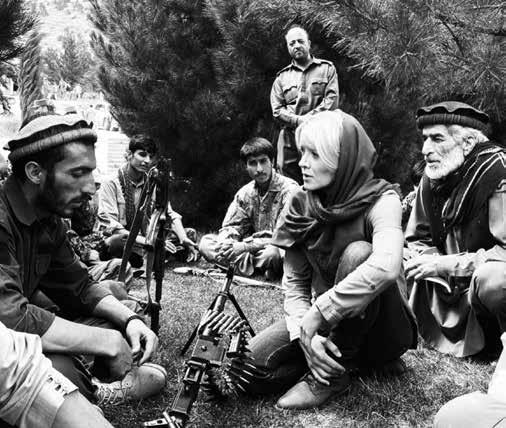
loss of their rights meant to women as individuals. I profiled a female gynecologist who worked her entire life to build a practice, rising to become one of the nation’s leading doctors. With the Taliban now in charge, she was faced with having to leave the country — and with it her right to practice medicine and her daughters’ access to education. She told her story with intensity and emotional honesty when I sat to interview her. This piece was not simply about the denial of women’s and girls’ rights, but the sacrifices mothers make for their children — something I knew many in the Western audience would relate to. Knowing the readership can be just as important as knowing the cultures from which you are reporting; a hard-won lesson learned by many foreign correspondents.
But those are the rules of news specials and features. When it comes to breaking news, it’s simply not possible or necessary for foreign correspondents to be on the spot when news happens. Today almost the entire world is carrying a camera in their
pocket. With social media, anyone is capable of sending information out like a news agency. The result? Reporting is technically open to anyone in the right place at the right time, and not limited to those working for news outlets. When Beirut was devastated by a massive explosion at the city’s port in August 2020, I had by pure luck just moved to New York City a few weeks before. As I unpacked boxes in my new apartment, I began seeing images and videos of the destruction of my former home. It took over an hour of scrolling through raw images on Twitter for news reports to even begin to clarify what had happened. It was a vivid example, and in this case a personal one, of the new norm of content appearing before verified news.
Beirut’s port explosion was an example of how powerful this ability to be connected to people in real time is. The world can be aware almost instantly of what is happening, which has proved to be a vital lifeline for those living under insufferable repression from regimes that effectively ban both international and domestic reporters.
In Myanmar following the military coup of 2021, the crackdown on pro-democracy activists was swift, brutal and conducted in the shadows. Fighting between ethnic armed groups and the junta has displaced over 2 million, according to the United Nations. Whatever trickle of images and information making it out is coming from local “citizen journalists.” This phenomenon began in earnest a decade before.
THE SYRIAN CIVIL War changed war reporting. It was a war where the rebels, hopelessly outgunned, welcomed and helped journalists visit the areas they held. Reporters like Paul Wood and myself were whisked from Beirut’s bustling streets and smuggled across the border to Lebanon to show the extent of the Bashar al-Assad regime’s crackdown on protests and the growing armed uprising. It was incredibly dangerous work, as exemplified in the killing of American journalist Marie Colvin on Feb. 22, 2012, but provided extraordinary access.
34 DESERET MAGAZINE
LETTERS FROM THE FIELD
THE AUTHOR MEETS WITH A MILITIA OF ANTI-TALIBAN FIGHTERS IN THE PANJSHIR REGION OF AFGHANISTAN IN 2021.
BLOCKING JOURNALISTS FROM WAR ZONES, DENYING VISAS AND DISCOURAGING THE VERY PRESENCE OF JOURNALISTS BY KILLING THEM USED TO BE SOMETHING MORE AKIN TO DICTATORSHIPS. IT HAS BECOME MUCH MORE COMMON THESE DAYS.
Driving through the night from Beirut to avoid detection from Hezbollah-allied soldiers, I was ferried through the backroads of Lebanon and foggy fields to the border. For several days I was passed from one safe house to another, hosted by a network of sympathetic civilians, until I was in the Baba Amr neighborhood of Homs city, the origin of the uprising. The activists, young men who had been involved in opposition protests for months, took massive risks to get me and my colleagues into Syria because they wanted the rest of the world to know what was happening. Over the noise of tank shells and the crack of sniper rounds, one of them laughed, “Welcome to Syria!” I shuddered.
In the control center of their rebellion, they sat around on the floor, frantically smoking, uploading videos and content they had shot to YouTube and Facebook. While the trickle of journalists making it into Baba Amr could only bring out a certain amount of footage and reporting, the activists took the lead in filling in the blanks. They were doing the job of news organizations for themselves, and many American and European outlets aired their footage from field hospitals and basements filled with sheltering civilians.
This footage was vital to helping the world understand what was happening after Bashar al-Assad claimed he was killing “terrorists.” But the footage was more activism than reporting, in large part because it was done with an outcome in mind. These young men wanted the West’s help. They had seen what intervention in Libya just months before had done to cripple the Qaddafi regime, and hoped for similar aid.
Sitting on the floor of the apartment they had based themselves in, they smoked and watched TV coverage of the emergency U.N. Security Council meetings, their laptops open, waiting for footage to upload slowly on a weak internet connection. “Do you think Obama will do a No Fly Zone?” one of them asked me. Most of the young men in that room would later disappear into Syria’s jails or battlegrounds and never be seen again.
Their work gave the world access to a war that a dictatorship did not wish to be seen. It also highlighted the limitations of such reporting. At times, the activists, both untrained in professional reporting and motivated by their desire to overthrow the Syrian government, partly staged scenes in some of their videos. At one point, they were caught setting fire to tires to provide a cloud of smoke behind them while addressing the camera.
Gaza is now the clearest example of a people filming their war for themselves and sending it out for the world to see. Technological advances, coupled with social media accounts, are providing an enormous platform for growing citizen journalism, as well as activism, as access has become one of the greatest challenges to the traditional war reporter. Blocking journalists from war zones, denying visas, preventing any embeds with militaries and discouraging the very presence of journalists by killing them used to be something more akin to dictatorships. It has become much more common these days, losing its taboo among democratic states. As the U.S.-led war in Afghanistan dragged into its final years, military commanders took advantage of the
growing apathy in the U.S. toward the war to effectively ban reporters.
If journalists aren’t able to gain access and report in conflict zones, we have no opportunity to utilize the strengths of foreign correspondence. Instead, our information will be limited, coming only from local activists and reporters. The more restrictions that are in place for those trying to bring information home, the more the fog of war will continue to crystallize into an impenetrable wall.
In 2019, after recording an interview with a senior Afghan defense official, I took the opportunity as we sipped tea to press him for access to Afghan troops on the battlefield. Afghan government soldiers and police were being killed in record numbers and I knew the Kabul government wanted the U.S. to acknowledge the sacrifices being made. I explained that commanders were denying our requests. “We would love to do embeds with American reporters,” said the official, before pausing and lowering his voice. “But we cannot.”
“The Americans have told you not to?” I asked.
“Yes, they have been very clear — no journalists,” he said, looking down at his hands.
Two years later, I and foreign correspondents from some of the biggest American media outlets all signed a letter of petition to the Pentagon, urging more transparency and access to the war in Afghanistan. There was no response. By the end of the war, the running joke was that it was easier to access embeds with the Taliban than it was with U.S. or Afghan government troops. It was — I spent more time with Taliban units than any other.
MARCH 2024 35

TO T HE S HIP
THE JOURNEY TO ALASKA’S MOST REMOTE BASKETBALL REUNION
 By KADE KRICHKO // Photography by ALANA PATERSON
By KADE KRICHKO // Photography by ALANA PATERSON
IT’S A CLEAR NIGHT
for a sail — a rarity for the Alaskan winter — as the ferry cleaves its way between inky mountain silhouettes. Samara Kasayulie-Kookesh sits silently in a white pool chair, braiding her sister Cheyenne’s black hair. Her fingers move deftly despite the cold; she’s accustomed to the frigid darkness. This is a journey she’s been making since before she could walk.
Ferries like this one, the MV LeConte, connect Southeast Alaska’s stretch of remote islands — home to the Tlingit and Haida — to jobs, groceries and conveniences taken for granted on the mainland. But tonight, the ferry is headed to Juneau for something special, for a tradition over a half-century in the making. Tonight, this boat is carrying Samara and her sister to a basketball tournament.
Tipping off shortly after the end of World War II, the Lions Club Gold Medal Basketball Tournament is one of the longest-running amateur sports tournaments in the country. Every March for over 75 years, thousands of Southeast Alaskans pack the gym at Juneau-Douglas High School for a week of games spread across four divisions. It’s a rowdy celebration of sport and culture, bringing together a geographically splintered community for annual bragging rights. While most of the country has its
eyes on the NCAA’s March Madness farther south, for a primarily Indigenous community isolated for most of the year, the Gold Medal has become a rallying point much bigger than the game itself.
Back on the MV LeConte, a maze of air mattresses and blankets covers the cabins and sprawls across the ferry deck. Kids, grandparents and village rivals from Hoonah, Kake and the Kookesh’s Angoon pack the LeConte. While high schoolers will occasionally crisscross these waters for league games, this vessel follows an extended, once-a-year tournament route, winding eight hours through icy straits to deliver teams to Alaska’s state capital by sunrise.
Samara, 20, a sophomore at Arizona’s Grand Canyon University, skipped spring break to fly in for the games. Even though she and her 18-year-old sister grew up shooting hoops on cracked driveways and later for Angoon’s high school team, it will be their first time playing as Gold Medal athletes together. It’s not their first Gold Medal ferry, however, as the pair has made the pilgrimage to watch cousins, aunts, uncles and even grandparents take the tournament floor. Their late grandfather, Albert Kookesh, helped lead Angoon to 11 Gold Medal championships over three decades. Their father, and their tiny fishing town’s
38 DESERET MAGAZINE
former mayor, Albert Kookesh III, is coming out of retirement to play in this year’s masters division. The Kookeshes aren’t unique in that regard. In the belly of the LeConte, handfuls of families can trace their Gold Medal history across multiple generations.
In the Alaskan night, Samara’s shoulders look unencumbered, light, even. With tomorrow’s tourney tipoff and Juneau’s Auke Bay Ferry Terminal still a few hours out, she cracks a quick joke with her sister and friends. There’s no mention of history, of games, or even basketball for that matter, but the fact that she’s floating here, multiple flights from the comfort of her college dorm, reflects a calling her grandfather once canonized for hundreds of Gold Medal faithful.
“(This tournament) is a religious journey to us,” he said. “Muslims go to Mecca, and each March, we go to Juneau.”
ALASKA MIGHT NOT seem like a basketball hotbed, but the relationship between basketball and the Last Frontier is older than the state itself. In many ways, it’s a love affair built out of necessity — centered around a sport that can be played indoors, illuminated and sheltered, year-round. Basketball also only requires five players to field a team — a big deal for communities that most often have high school graduating classes smaller than the roster of an average-sized football team.
“The small villages don’t have enough kids for a football or a baseball team,” says Bob Sims, a local referee who has been announcing Gold Medal tournament games for radio station KINY since 1975. “In these remote areas, there isn’t even a place for them to play other sports.”
The state’s earliest teams date back to 1914 and the industrial fishing town of Sitka, but the sport’s influence quickly crept up the straits and inner passageways of Southeast Alaska. When the Alaskan Native Brotherhood, a community organization founded in 1912 to advocate for and protect Indigenous rights, built lodges in remote native communities, they included gyms

THE DRIVE FROM ANGOON TO THE FERRY PORT IS JUST THE FIRST OF MANY PARTS OF THE JOURNEY FOR ALASKA’S GOLD MEDAL TOURNAMENT HOPEFULS.
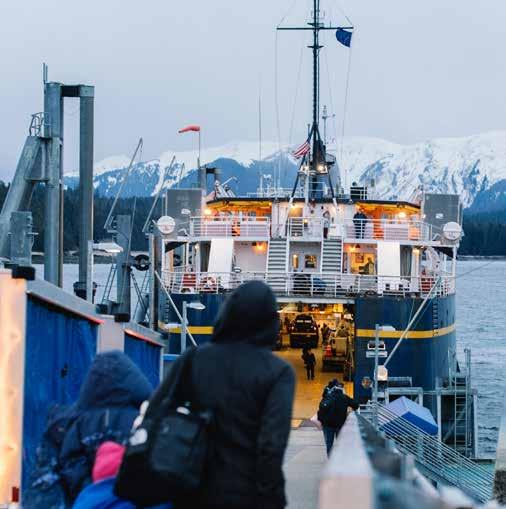
“THIS TOURNAMENT IS A RELIGIOUS JOURNEY TO US. MUSLIMS GO TO MECCA. EACH MARCH, WE GO TO JUNEAU.”
MARCH 2024 39
in their common spaces. Soon town teams — and the rivalries that come with them — began springing up across the region.
When Del Hanks, a Boy Scout executive whose work with the scouts brought him up and down Southeast Alaska, saw those matchups firsthand in the late 1940s, he approached the Juneau Lions Club with a proposal: Basketball-crazed villages were already taking fishing boats across the Chatham Strait to play each other; why not bring them all to the capital for a single tournament? The Juneau Lions Club Gold Medal Basketball Tournament was born

in 1947. Soon, crowds delighted over local talents like Herb Didrickson, a 5-foot-10 Tlingit-Norwegian guard from Sitka dubbed the “Jim Thorpe of Alaska.”
“His hands were just so quick,” remembers 84-year-old Paul White, a four-time Gold Medal champion and Gold Medal Hall of Famer from Hoonah, Alaska. “He could just jump and hang on the rim.”
Didrickson was the first Native player to carve his name into the Gold Medal’s history. But soon Paul and his brother Frank followed with big wins and big legacies, alongside players like Hoonah’s Stu Mills, 67, who, over 42 years, competed in 24 Gold Medal championships, winning 12. Kookesh, who would go on to become an Alaska state senator before passing away in 2021 at the age of 72, won almost that number for Angoon — many at the expense of Mills and his Hoonah rivals.
Where most basketball rivalries end in high school or, for the rare few, after college, Gold Medal opened the door for hardwood matchups that spanned lifetimes, with age brackets that span from high school to elderhood. Kookesh III says he played against his biggest on-court nemeses — legendary squads from Hoonah, Hake, Sitka — over a span of 30 years. Rivalries that long-running come not only with aging knees, but with a shift in perspective.
“In high school, there might have been a lot of animosity, but as you get older, it turns to respect and love,” says Kookesh III, 45. “A lot of players I battled for years are now some of my best friends.”
The tournament ran uninterrupted from 1947 to 2019, making it one of the longest-running tournaments in the country. For years, schools planned their spring break around the tournament, allowing entire towns to descend upon Juneau for a weeklong celebration. For finals games, several thousand pack out the Juneau-Douglas High School gym. “The firemen stay home, otherwise the last one in the village turns the lights out,” laughs Sims.
Stepping from under the gray skies of March and into the Juneau-Douglas High
40 DESERET MAGAZINE
A TIPOFF AGAINST YAKUTAT MARKS THE BEGINNING OF ANGOON’S GOLD MEDAL PLAY ON MARCH 21, 2023.


WALKING DOWN ANGOON’S PUDDLE-MARKED STREETS, IT’S IMPOSSIBLE TO MISS THE HOOPS.


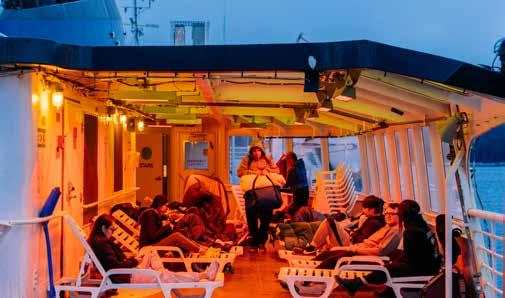
School gym is akin to passing through a portal. Squeaking sneakers are barely audible over the noise, chants raining down from one grandstand before return volleys cascade from the other. Fans hover over takeaway pizzas — food not available back home — and vendors walk around with steaming fry bread. Angoon’s Dorothy Gamble sits courtside covered in a woven blanket. Her granddaughter Samantha Ramey plays for Angoon alongside the Kookesh sisters, and she still wears her late husband Ed Gamble’s gold medal around her neck, but she doesn’t have any allegiance to the teams currently on the floor. “I only cheer for Angoon,” she says. But, minutes later, in a game between Kake and Hydaburg, she can’t help herself. “We want a basket!” she hollers.
Further down the sideline, Paul White and his wife, Edwina, cheer on their nephew. Now well into their 80s, the 2023 return to Gold Medal isn’t lost on them. “This is what we needed,” says Edwina. “It’s the glue that brings us together.”
WALKING DOWN ANGOON’S puddle-marked streets, it’s impossible to miss the hoops.
Portable plastic backboards rolled in driveways and backyards. Rims hanging from woodsheds and above smokehouses full of cockles, salmon and Sitka deer. Through front windows, nets rest above trash cans and stick to bedroom doors. “Basketball is where we go to be social,” explains Kookesh III. “We don’t have nightlife — no bars, no gathering places — just our gyms.”
A curling hook of land jutting into the swirling Chatham Strait, Angoon is the only permanent municipality on Admiralty Island. The village, which has a population of under 350 year-round inhabitants, rests at the crux of deep blues, misty greens and dark, heavy grays. Its waters — though depleted since the days of its early inhabitants — are still favored by halibut and king salmon. Decades ago, the Tlingit outpost was one of few Native corporations to outlaw commercial logging, and today scores of bald eagles glide over thick forests. The island’s Tlingit name, Kootznoowoo, translates to “fortress of the bears.” When they’re awake, there are more here than anywhere else in the world.
There are only seven miles of road in town, none of them leading in or out.
MARCH 2024 41
THE FIVE-HOUR FERRY RIDE FROM ANGOON TO JUNEAU IS NOT A ROUTE OFTEN TAKEN. IT ONLY RUNS TWICE A WEEK, TWICE PER MONTH.
“BASKETBALL IS WHERE WE GO TO BE SOCIAL. WE DON’T HAVE NIGHTLIFE — NO BARS, NO GATHERING PLACES — JUST OUR GYMS.”

Angoon is connected to Juneau by a floatplane flight or a ferry that runs twice a week every other week. While there is a small grocery store in town, items like toilet paper and bulk food are often flown in (if the weather cooperates). The town relies on three generators, and the ferried-in oil they run on, to power its modest electrical grid.
It’s also home to three basketball gyms. Every night at 7 p.m., students, construction workers, local government officials and even the region’s school superintendent get together for pickup at Angoon High School. It’s less a workout than a hangout — a rotating cast of games to 11 and free-throw competitions.
A few inches off the 3-point arc, Samara Kasayulie-Kookesh finds her spot. Snapping her wrist, she sends synthetic leather through twine, a motion she’s repeated thousands of times. Wearing sweatpants and over-the-ear headphones, Cheyenne kicks the rebound back out to her older sister. Her senior night banner, a white-markered blue poster reading “Cheyenne Kick-Ash,” still hangs in the corner of the high school gym, weeks after her final game for the Angoon Eagles. Catch, shoot, rebound, pass — the pair glide through an
almost unconscious hardwood meditation.
“This feels familiar,” says Samara. “Here, I can relax.”
Before transferring to Grand Canyon University, she spent a year playing at Feather River College in California but says the sport started to feel like a job. It was a change from growing up in remote Southeast Alaska, where basketball wasn’t just a game, but “an excuse to come together.”
A few days before Gold Medal, that excuse takes on added importance, each shot from beyond the arc a little closer to the bright lights of Juneau. In a series of pickup games, the Kookesh sisters mix in with the men’s teams, joined by Ramey, as well as Lizzie and Tricia O’Brien, another pair of sisters who reside in Angoon.
The other half of the team will join them in Juneau, with players now scattered between Anchorage, Hoonah and the capital city. A pandemic and slashed transportation budgets have only accelerated the exodus of young people, grounding ferry lines to a near-halt in 2020 and forcing industries that relied on the aging transportation system to circle their wagons in more populated areas.

BOTTOM: ED HOTCH, JUNEAU LIONS CLUB ACTING PRESIDENT, ORGANIZES A WIDE ARRAY OF VOLUNTEERS TO PULL OFF THE TOURNAMENT EACH YEAR.
OPPOSITE: CARMEN ESTRADA TALKS STRATEGY FOR ANGOON DURING A TIMEOUT AGAINST YAKUTAT AS SAMARA KASAYULIE-KOOKESH (12), TRICIA O’BRIEN (5) AND THE REST OF THE TEAM LISTENS IN.
42 DESERET MAGAZINE
TOP: LIZZIE O’BRIEN AT THE LINE FOR ANGOON AGAINST YAKUTAT IN THE 2023 GOLD MEDAL TOURNAMENT.
Carmaleeda Estrada grew up on hand-hung hoops in the village. She moved to Juneau after college in 2007, finding work as an operations officer at the Sealaska Heritage Institute, a Native-run nonprofit focusing on promoting the Tlingit, Haida and Tsimshian cultures of Southeast Alaska. Her parents still live in Angoon, and she makes the trek out every other month, but returning to her hometown doesn’t feel like an option right now. Opportunities are tougher to come by in a town where the unemployment rate is 13.5 percent (nearly triple the state average). It’s not an isolated problem in Southeast Alaska, but it’s a reality that Estrada and many her age have had to contend with over the last decade.
“All of our rural communities have struggles that make it hard to go back,” says Estrada. “Lack of job opportunities, lack of housing and high cost of living are the reasons many people who want to live there can’t. I ended up in Juneau because if I can’t live in Angoon, I still want to be close to home. (This way) I can easily visit my parents or they visit me, or send groceries and supplies when something is needed.”
Estrada wants to see that kind of help go further, to the kids in her community who will soon face the same decisions she did. The Angoon point guard has been raising raffle money to help her teammates cover hotel costs during their week in town and helped the team purchase new jerseys for the tournament. For nearly a decade, she has also been her team’s biggest advocate.
Gold Medal Tournament co-chair Tim Wilson says that while gym space has gotten pricier over the years and budgets are tight, the club will still hand out three to four $1,000 scholarships for each participating community after the tournament, a decadeslong tradition established to help small villages send students to college. “I don’t think people realize this, but most everything we make, we give away,” says Wilson, a Gold Medal player himself.
It’s perhaps this cyclical nature, rather than the annual gathering itself, that has twisted the roots of the tournament so deep
around the heart of the communities. At any given game, old-timers like White line the gym’s back wall, admiring a generation that once worshipped them from the bleachers.
“We watched the NBA, but mostly we watched Native tournaments,” says Samara in the grandstands between games. “This is what we looked up to.”
ANGOON’S WOMEN’S TEAM is in trouble. Yakutat is moving the ball, and its two-time Alaska high school player of the year, Rose Fraker, is hot. Estrada makes a couple long 3s, but Yakutat’s strong screens and aggressive fast break have stretched the lead to double digits. Samara’s shot is off, and Cheyenne, the youngest player on the court, anxiously searches for passing lanes through bigger bodies.
With the clock ticking under a minute, Cheyenne meets Fraker at halfcourt. Seeing the play in slow motion, her sister creeps up from behind, and as the former all-star picks up her dribble, Samara pokes the ball free. In one motion, Cheyenne takes off. From the top of the grandstands, Albert’s voice booms over the crowd’s crescendo. Grabbing the loose ball, Cheyenne drives
into the key and puts the ball calmly off the backboard and in.
It’s a glimmer of gold in a tournament that will end up bookended by Fraker and her team. Angoon drops its first game, then rallies for two wins against Hoonah and Hake. But they can’t find the answer to Yakutat, falling once again in the Gold Medal semifinals, and ending their tournament. The last Saturday of Gold Medal, the Angoon squad looks on as Prince of Wales finally ends Yakutat’s run, lifting the championship trophy from center court.
The Southeast Alaskan basketball reunion is over as quick as it began. On a mild Sunday, the Kookesh sisters step back on the ship with family, friends and rivals. Dozens move more gingerly than a week ago. Samara still has a few days back in Angoon before she flies back south for spring semester. Cheyenne returns to a looming college decision and high school graduation in the months ahead. But their minds are already back in the Angoon High School gymnasium. Maybe they could get a few shots up tomorrow before the pickup crowd rolls in.
The lights turn on at 7.

MARCH 2024 43
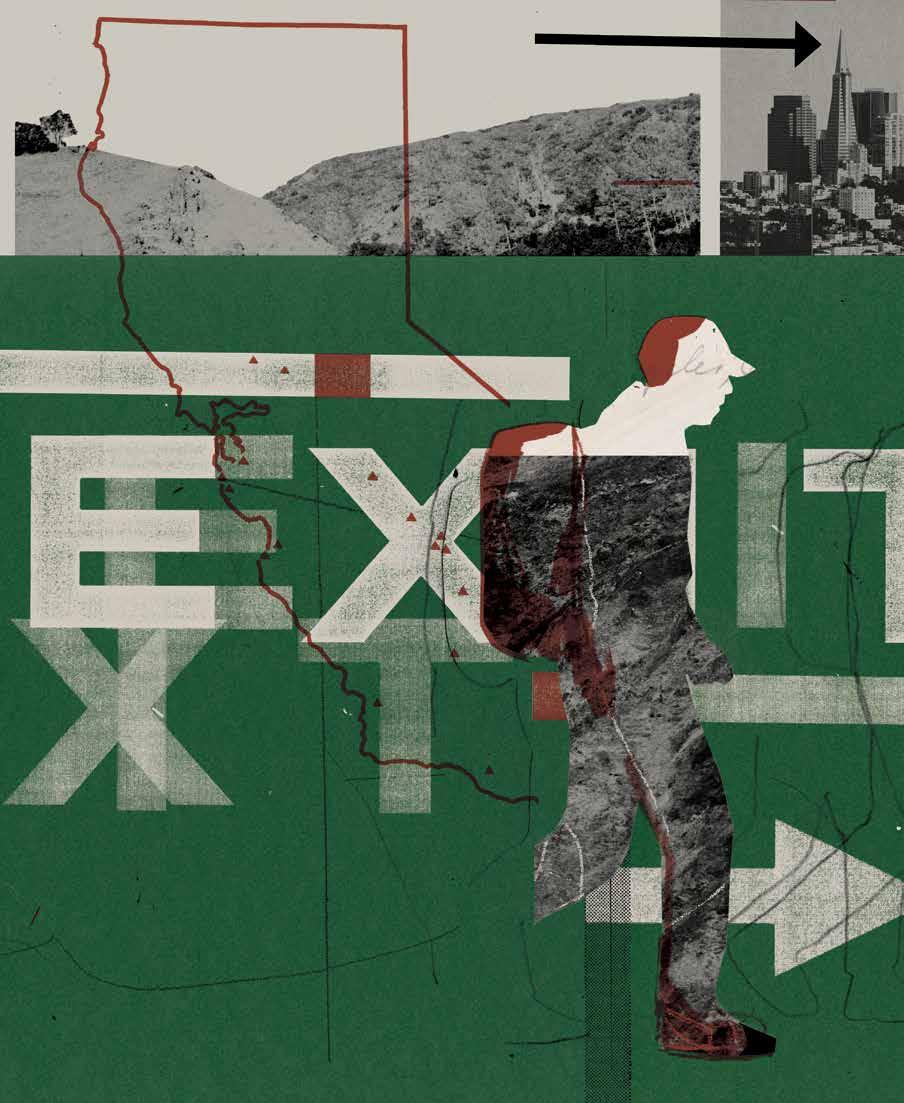 BY Natalia Galicza
ILLUSTRATION BY Mike McQuade
BY Natalia Galicza
ILLUSTRATION BY Mike McQuade
CALIFORNIA?
Once heralded as a beacon of prosperity, the state has suffered from housing shortages, climate change and a media fixation on crime in recent years
Is this why people are moving out in droves?
MARCH 2024 45
The wealthiest state and the state with the highest level of poverty. It carries tremendous social and political influence while serving as the butt of national jokes. It has tantalized generations of newcomers in search of fame and fortune — whether through the gold rush, Hollywood or tech booms — while granting it to a disproportionate few. Yet it has remained a beacon of hope to flock toward. Until now.
More than 800,000 Californians left the Golden State between 2021 and 2022. Last year, tens of thousands more were added to the tally. The drastic drop in population even prompted the state to lose a congressional seat for the first time in its history. California has long been held as the core of population growth for the country, yet it’s also struggled with resident retention every year since the start of the new millennium. Population has naturally ebbed and flowed, due in part to factors like international migration, a decrease in births and an increase in deaths. But more recently, people fleeing to other states is the driving force for the dwindling figures. The state now stands on
an unprecedented precipice — one where its challenges outweigh its allure.
The housing crisis, worsening crime and climate concerns are at the forefront of the exodus. The state’s housing and rental markets are among the costliest in the country, especially in southern cities like Los Angeles. The National Low Income Housing Coalition reports there are only 24 affordable and available rental homes for every 100 extremely low-income renter households statewide. Other metropolitan hubs like San Francisco have suffered an uptick in high-profile crime — from the fatal downtown stabbing of a tech executive to the carjackings and smashed store windows spreading across the city like contagion. And while people struggle to find housing or fear for their safety, climate change introduces its own hurdles. The state’s sea level rises, its wildfires worsen, its Central Valley sinks lower into the ground and its water management whiplash — from severe droughts to dire floods — further strains resources.
All these problems have thrust California into an unflattering national spotlight.

46 DESERET MAGAZINE
FREDERIC J. BROWN / AFP VIA GETTY IMAGES

When Gov. Gavin Newsom appeared on Fox News’ “Hannity” last June, he grew defensive when asked about the residents who have fled in recent years and about the roster of influential companies who have similarly shipped off. “I love this state,” he pleaded to viewers. “Don’t count us out.” Though, by the urgency heard in his voice, it’s clear how many already have.
‘OUR HOUSING CRISIS IS OUR HOMELESS CRISIS’
FRANKIE ARTURO GOMEZ doesn’t know where he’s from. When asked, the 30-year-old lists cities across Southern California: Hesperia, Downey, Bellflower, Los Angeles, Long Beach. No answer feels exactly right. No one city feels like home; due in large part to the fact that he’s almost forgotten what it’s like to have one.
We met at the Long Beach Rescue Mission in December at a cafeteria-style table in the dining hall. Around us, volunteers buzzed by in blue aprons to arrange the place settings: paper napkins and plastic cutlery in front of every seat. The mission is one of hundreds of nonprofits that offer resources like food, clothing and shelter to the homeless community in Los Angeles County. Gomez, more than a year into the mission’s New Life Program, has a place to sleep, to seek counseling for substance abuse and to work as a lead overseeing the kitchen staff. But like any other nonprofit in the area, its resources are limited. “When I was allowed in, it was like a blessing to me,” Gomez says. “I don’t talk about God like that in any type of way, but it was a miracle.”
Gomez has cycled in and out of homelessness since he was 18 years old. His calloused hands fidget nervously as he speaks. He’s not often asked about his past. Before he arrived at Long Beach Rescue Mission, he spent three years living on the streets in Downey and East Los Angeles. He jumped from city to city in search of shelters, only to find how finite residential programs are across Los Angeles County. He’s been
turned away from services more times than he can count.
Grappling with the problem of homelessness in America, or the housing crisis writ large, begins to some extent in Los Angeles. Think of it this way: About 30 percent of the nation’s homeless population, or 181,399 people, resides in California, and nearly 40 percent of those live in Los Angeles County.
The 2023 Greater Los Angeles Homeless Count estimates more than 75,000 people experience homelessness across the county on any given night. That number is up from the previous year, yet the number of people in interim housing programs remains unchanged at just over 20,000. It’s the most populous and overcrowded county in America, as well as one of the nation’s least affordable housing and rental markets. And it mirrors a problem that plagues the whole state. About 70 percent of homeless Californians live on the streets — more than anywhere else in the country. That leaves people like Gomez with scant resources to support them.
Gomez says he has just over half a year left in his current residential program at the mission. Afterward, he’s not sure where he’ll go. He hopes to save enough money from working as a kitchen lead to be able to afford a place of his own. For now, that remains a distant hope.
After our conversation, as I drive to downtown Los Angeles, I think about how uncertain he feels for his future, how that uncertainty has lingered now for years. It exists in tandem with a nationwide uncertainty about California’s own future. The shedding of its population is beginning to look less like a fluke and more like a key characteristic for the state’s emerging identity.
Interstate 110 drops me downtown and immediately I’m within view of several encampments. Encampments near the highway exit, encampments straddling the precarious edge of an overpass, encampments on sidewalks. There are clusters of tattered tents and tarps in every conceivable direction. Just east of here, LA’s famous tent city, Skid Row, unfurls across 50 blocks. Last
MARCH 2024 47
THAN 75,000 PEOPLE EXPERIENCE HOMELESSNESS IN LOS ANGELES COUNTY
NIGHT.
MORE
ON ANY GIVEN
May, the Biden administration launched a new homelessness initiative that focuses on eliminating barriers to housing. Only six nationwide locations were chosen to spearhead the effort — Los Angeles and the entire state of California are two. “Our housing crisis is our homeless crisis. The lack of access to housing because we don’t have enough product has created our homeless crisis,” says Stephanie Klasky-Gamer, president and CEO of the homeless services nonprofit LA Family Housing. “And there is not one neighborhood across Los Angeles — from the valley to the city, from the westside to downtown — where you don’t see people experiencing homelessness.” The primary culprit behind the crisis — beyond crime, mental illness or substance abuse — is a lack of affordable housing.
A survey published by the nonpartisan Public Policy Institute of California found the cost of housing weighs on the minds of millions of Californians every day. For many, especially in Los Angeles, it’s incentive enough to leave altogether. In 2018, the California Department of Housing and Community development estimated 180,000 new homes needed to be built statewide every year for the next seven years to drive prices down for homeowners and renters in step with the growing affordability gap; fewer than 80,000 homes a year were built over the last decade. Mayor Karen Bass and Newsom have respectively allocated billions of dollars in programs to spur housing construction and shelter options on the city and state level. Yet decades of slow growth land use policies, generations of urban sprawl and bureaucratic barriers to construction have rendered that funding inadequate in keeping up with the pace of the crisis.
“It’s going to take more than three years to envision and finance a project before you even start construction,” Klasky-Gamer says. “When you have 30 years of slow growth strategy, you’re only creating greater barriers for people accessing housing because you’re not building at the pace that the population is growing.”
High prices and demand for housing are not new issues or unique challenges
to either America’s most populous state or its most populous county. When those challenges come to a head, however, it’s a warning shot for the rest of the nation. If the maxim “as California goes, so goes the country” remains true, it’s imperative to understand the state’s housing shortage and its inevitable aftershocks, crime among them.
“THEY KNOW THERE’S NO PENALTY”
MICHAEL SIMPSON REGAINED consciousness in his driveway. He didn’t know how he got there. Around him hovered an orbit of paramedics, asking him questions he couldn’t answer, as they wheeled him into an ambulance. The 71-year-old physical education teacher had been found in front of his Richmond, California, home late one October night, sprawled out on the pavement, bleeding from a head wound. The injury was a mystery. The only thing he knew for certain was he’d gotten it some 20 miles away in San Francisco.
Earlier that evening, he’d driven into the city for the memorial service of a close friend. Around 9pm, as he walked back to his car, parked in an alley in the Lower Nob Hill neighborhood, on the periphery of the Tenderloin district, he heard the sound of his Prius chirp open.
At the hospital, the staff told Simpson he’d need 15 stitches to piece his head back together. His skull was fractured in the pattern of a peace symbol, the fissures agape and hemorrhaging. “I couldn’t remember anything. I was in concussion protocol. I could not walk, I could barely talk,” he later told me. “The doctors felt like my abrasions were as a result of a blow, that I was hit with a baseball bat or a pipe in the crown of my head. That’s the only thing that saved me. Otherwise, they said if it had hit me in the side of the head, like on the temple, I would not be with them.” He’d somehow managed to drive half an hour home from the city in a complete blackout as he bled into his fedora. His neurosurgeon speculates that
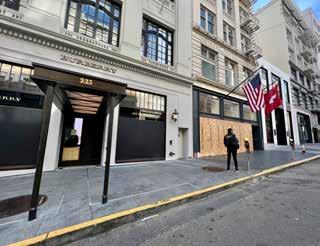

TOP: EVEN THE TONIEST NEIGHBORHOODS OF SAN FRANCISCO HAVE SEEN A RASH OF SHUTTERED RETAIL AND BOARDED UP STOREFRONTS IN RECENT YEARS.
BOTTOM: THE CAMP FIRE IN PARADISE CLAIMED 85 LIVES AND REAPED AT LEAST $16.5 BILLION IN DAMAGE. TODAY, ONLY 20 PERCENT OF THE TOWN’S PREFIRE POPULATION OF 26,000 CALL PARADISE HOME.
48 DESERET MAGAZINE
when he arrived home and stood to exit his car, the loss of blood rendered him unconscious.
The attack did not appear financially motivated. Simpson still had his keys, his wallet and all his cash. He later contacted the lounge to learn there had been a recent rash of attacks on Polk Street: robberies at gunpoint, passersby yelled at and spit at by unknown instigators. He was told a couple of homeless people live in the alley where he parked, and they react aggressively toward perceived intruders. “They claim that alley is their home and you’re trespassing if you’re in that alley,” he says. Simpson suspects those were the people who attacked him. Though he’ll never get the answer.
He had seen cellphones snatched on the Bay Area Rapid Transit system; he’d watched groups of men try to steal his car’s catalytic converter from his driveway. But those instances were mostly sporadic and confined to late hours of the night. Now he says crime feels constant in San Francisco, the city of his birth. “It’s probably not as bad as some other places across America,” Simpson says, “but it’s definitely lost its shine.” He doesn’t go into the city unless it’s absolutely necessary. “Especially at night. Especially now.”
Dozens of retail stores have shuttered in San Francisco’s Union Square — the core of commerce in the city — since 2020 and dozens more have closed in nearby neighborhoods. Companies like Nordstrom and Whole Foods shut down flagship locations in the area last year. Memos show the retailers framed these decisions around “dynamics of the downtown San Francisco market” and worker safety. Robberies across the remaining luxury shops have intensified; like in July, when a Louis Vuitton, Gucci and Burberry were all hit in the same week. “You have the so-called ‘Snatch and Grab,’ and folks are not being held responsible for it,” says Cheeko Wells, an outreach worker for the city government-led San Francisco Violence Prevention Services. “It’s easier now.” Research from the Public Policy Institute of California ranks the San Francisco
Bay Area as the region with the highest rate of property crime in the state, with some 3,036 cases for every 100,000 residents. The Bay Area saw a 24 percent increase in retail theft and commercial robbery as well as a 26 percent increase in commercial burglary from 2019 to 2022.
Much of the blame is assigned to liberal leadership. Chesa Boudin was elected as San Francisco’s district attorney in 2020 after winning by a slim margin of 3,000 votes. He vowed to curb prosecution of “quality-of-life crimes,” or crimes that criminalize poverty and homelessness. That categorization was meant to include offenses like public camping or blocking sidewalks. When his tenure began, however, the rise in property crimes and homicides that coincided with the effects of the pandemic began to look more like the results of his policy. Boudin became known for sending a larger number of cases involving robberies, assaults and petty thefts to pretrial diversion programs — including counseling and rehab — and convicting fewer defendants than his predecessors. Only 18 percent of cases resulted in diversion programs in the year before Boudin’s inauguration. Two years into his appointment, 42 percent of cases were resolved via diversion (rather than court proceedings and potential jail time), allowing an unprecedented number of offenders back on the street.
Boudin’s status as a symbol of prison reform and progressive prosecution quickly made him a target of criticism. One year into his role as district attorney, the San Francisco Chamber of Commerce found 8 in 10 residents reported experiencing more crime. Hundreds more cases of aggravated assault and thousands more thefts were reported to the police department over the previous year. “I really started paying attention,” says Marie Hurabiell, an eighth-generation San Franciscan. Hurabiell is a board member of Stop Crime SF, a community watchdog organization. She joined in 2016 after what she calls a citywide spate of burglaries and thefts, one of which she experienced in her own home.
30% About
of the nation’s homeless population resides in the Golden State, and nearly half of that population is in Los Angeles County. The primary culprit — beyond crime, mental illness or substance abuse — is a lack of affordable housing.
MARCH 2024 49
The San Francisco Chamber of Commerce found that
8 in 10
residents felt as though crime had worsened in the city.
After Boudin’s appointment, Hurabiell took a leave of absence from her job at a tech company for one year to study the effects of his administration. “I had my first thoughts of, ‘I can see why people are leaving.’”
Just over halfway through his four-year term, Boudin was removed from office after opponents and conservative pundits pushed for a recall election. That decision had a much wider margin than his election — more than 20,000 votes. His successor, Brooke Jenkins, told news outlets during Boudin’s recall campaign that “he’s creating a landscape where criminal offenders desire to come here and commit crimes. They know that there’s no penalty.” (Boudin didn’t respond to my interview requests.)
Despite Jenkins’ criticism of her predecessor and her vocal disapproval of his progressive prosecution policies, many of the same conditions that existed under Boudin persist under her tenure. One year after Boudin’s removal from office, robberies in San Francisco increased by 15 percent and motor vehicle thefts by nearly 10 percent. “The criminality is just blatant,” Simpson told me. “You can’t unring that bell.”
IN THE SHADOW of the city’s ritzy retail hubs are the open-air drug markets in the Tenderloin district, San Francisco’s highest crime neighborhood. It’s less than a mile away from the tourists and boutiques of upscale Union Square but takes on an entirely separate reputation as a “containment zone,” or a place where illegal activities are tolerated
in hopes they don’t happen elsewhere.
A quick walk through a few of the area’s 50 square blocks reveals a confused combination of acclaimed restaurants, drug deals, four-star hotels and public urination — all in broad daylight and within view of City Hall. Drug stores with chained-off aisles, storefronts with plywood-clad windows and vehicles dusted with shards of glass, all part of San Francisco’s new persona, epitomize the Tenderloin. But the district’s foremost problem is not the business closures. It’s the drugs.
Citywide, the number of reported incidents of drug possession, sales and transport has doubled within the last two years, from 2021 to 2023. And in September 2023 alone, 54 people died in the city because of accidental overdose — a third of whom were Tenderloin residents. Brian Clark, special agent in charge of the Drug Enforcement Administration’s San Francisco Field Division, has called the district “ground zero for drug tourism.”
Mayor London Breed made the problem a focus of her first term. Inaugurated in 2018 and the first Black woman elected as mayor of San Francisco, Breed grew up in the city’s Plaza East Public Housing project, a neighborhood notorious for its history of gang violence. Drugs were an impetus of strife among her neighbors and family members, including her brother Napoleon Brown, who dealt and used from a young age. Amid the Tenderloin’s fentanyl epidemic, Breed issued a state of emergency to expand the presence of law enforcement
in the area, despite a severe police staffing shortage. The added surveillance contributed to a 121 percent increase in overtime for the police department.
Since then, both the state and federal government have stepped in. Newsom — a former San Francisco mayor — announced the creation of a task force dedicated to investigating the city’s opioid deaths in October. He also tasked California Highway Patrol officers and National Guard troops with canvassing the area. As part of the initiative, agents from the DEA, Federal Bureau of Investigation and the United States Attorney’s Office are working together to prosecute more street-level drug traffickers with federal charges. Still, even after hundreds of arrests and hundreds of pounds of confiscated narcotics, the city saw its most fatal year for drug overdoses on record last year. More than 800 people died across San Francisco.
On a weekday this past December, I witnessed a man and a woman, presumably a couple, occupy a Tenderloin street corner, seemingly frozen in place. The man hovered on the edge of the sidewalk with his head leaned forward, coils of brown hair covering his face. The rest of his body stuck at an obtuse angle, somewhere between standing and lying down. The woman stood with her knees at 90 degrees. Her head was similarly bent forward, her hair gently grazing the ground. The pair was likely nodding off, a symptom of drug use commonly associated with opioids like heroin and fentanyl. But they looked like fixtures of the city,
50 DESERET MAGAZINE

MARCH 2024 51
1/3
Almost of Americans in 2022 said climate change was a motivation for moving. And California is ranked among the top five states to suffer economic fallout because of climate disasters.
statues suspended in space, the pedestrians who rushed around them either unseeing or unphased.
“PERIODS OF DROUGHT … AND PERIODS OF PLENTY”
AS THE WORLD warms, a new host of climate issues abound. California is hardly immune. Rising oceans, floods, wildfires and droughts. All are worsening and inspiring its residents to abandon ship.
The National Oceanic and Atmospheric Administration reported the sea level off California’s coast has risen by six inches since 1950. Over the last decade, the rate of that rise has sped up to an added inch every 10 years. More people are at risk of rising oceans in California than anywhere else in America — the state has the greatest number of coastal residents to feel the effects, as well as billions of dollars’ worth of property. Coastal erosion has already begun to reshape its coastline and threaten its wetlands, the majority of which could disappear in the next century. The more wetlands are destroyed, the more things worsen: water pollution, floods and droughts. The droughts, when combined with rising global temperatures, create arid conditions that cause wildfires.
Of the state’s 20 most destructive blazes, 14 occurred within the last decade. They burned down more than three million acres and 41,000 buildings. Fire season, once largely confined to the stretch of time between April and October, is now year-round. What was once record-breaking is now regular. And when the land is as sensitive and susceptible to flames as it’s become, even the most freakish of accidents can ignite the worst tragedies.
Like on November 8, 2018, when a faulty electric transmission line caught fire in Northern California’s Butte County. High winds and ponderosa pine needles fueled the sparks into an inferno as it battered its way to the nearby town of Paradise. What became known as the Camp Fire remains
California’s deadliest and most destructive wildfire. It claimed 85 lives, 19,000 buildings, cost at least $16.5 billion in damages and rendered the rural community of 26,000 to ash within a single day. “Nobody thought that the town was going to be incinerated,” Ashley Gilmore, a former resident whose childhood home burned down that year, told me. She’d been living 20 miles away in Chico by the time of the fire — close enough to watch her former community spill out of their small town. She later visited the barren lot where her family’s home once stood. “I don’t see myself at this point ever rebuilding,” Gilmore said between tears. “What it was for me, in my childhood, it will never be that. So I kind of gave up that hope.”
Only about 5,200 people — or about 20 percent of the pre-fire residents — still call the town home. When Gilmore’s parents lost their house of more than four decades, they moved to Salt Lake City, joining the ranks of the more than three million climate migrants across the country who have moved states away to lessen the risks of environmental calamity. A Forbes Home survey published in January found that almost a third of Americans in 2022 said climate change was a motivation for moving. And November’s Fifth National Climate Assessment, hailed by the federal government as the nation’s foremost assessment of climate change, ranked California among the top five states to suffer economic fallout because of climate disasters.
For communities who have already experienced climate-induced catastrophe, or live in persistent fear of it, the cost-benefit analysis of establishing or maintaining roots in California can be foreboding. Especially when risks rise with each passing year.
I DROVE TO Tulare in the dark. Nightfall obscured the pistachio farms and dairy plants that loomed outside my driver’s seat window. Still, I could tell I’d arrived when I noticed the smell. Both the county and its eponymous city are known nationwide as leaders in milk production. The
52 DESERET MAGAZINE
manure- and fertilizer-tinged air quickly makes that clear. Though in recent years, the area has captured national attention by way of another precious resource — in both its abundance and absence.
Tulare County lies in the San Joaquin Valley, which is the southern portion of the state’s Central Valley, the most productive farmland in the country. It’s simultaneously home to California’s agricultural heartbeat and its most challenging water management woes.
The region’s residents and agricultural giants all rely on groundwater pumping to withstand frequent periods of drought. Overdraft causes thousands of wells to fail and renders households across the valley without immediate access to water during dry spells, like the latest three-year drought that ended in 2022 and brought with it some of the driest years in state history. “The biggest concern that the entire San Joaquin Valley has, all the way up to the Sacramento Valley and even other parts of the state for that matter, is the need for water,” says Tom Tucker, agricultural commissioner for Tulare County. “We’re generally either in a drought or at the very least, in a situation where we’re using more water than we’re receiving or we’re storing.” But it’s also a region susceptible to flooding. And in 2023, it endured just that.
In what is perhaps the most illustrative example of California’s cyclical climate concerns, the drought-stricken state suffered back-to-back storms with record amounts of rain and snow all throughout winter. Climate change makes that weather variability, or “precipitation whiplash,” more common and intense. The torrents were fueled further by atmospheric rivers, streams of vapor that can carry hundreds of billions of gallons of water through the air in a single day. “It’s a historic pattern. … There’s periods of drought, and then there’s periods of plenty,” says Tulare Mayor Terry Sayre. “As it progresses through the years, you have more people, more homes, so it changes the severity or the urgency of it.” At least $60 million in agricultural losses
were estimated in Tulare County as a result of floods. And that’s because Tulare Lake, empty for almost three decades, reemerged with the storms.
The freshwater lake was once the largest body of water west of the Mississippi River. It spanned almost 800 square miles during wetter years, reaching as far as the San Francisco Bay. But in the 1800s, European settlers chose to drain the lake to pepper the floodplain with crops. The decision resulted in incredibly productive farmland, but it also doomed the surrounding communities with added flood risk.
As agricultural operations suck more water out of the basin’s aquifer, the San Joaquin Valley collapses into itself through a process called subsidence, which means the land is sinking. Subsidence worsens as the aquifer depletes. It damages nearby infrastructure and results in flood-prone communities. Tulare Lake’s 2023 flood drowned hundreds of thousands of acres of farmland. It swallowed homes and rural highways, shut down dairy plants and rendered thousands of agricultural workers unemployed. Worse yet, much of the water couldn’t be preserved with the region’s limited number of reservoirs. Tucker says the infrastructure in place is built for an average year of rainfall. Nothing more. “This 40-year flood bought us one year.”
Statewide efforts to divert what’s left of the lake have stretched on for over a year. It could take years more for the waters to fully recede and restore the submerged farmland. Even then, the threat of flood lingers. Tulare Lake has reemerged four times before 2023; there is no telling if, or when, it will rise again.
AS MUCH AS California’s condition can shape the attitudes and population of the country at large, the reverse is also true. Yes, Californians cite housing, crime and environmental issues as growing concerns. But, so, too, does the nation. Recent Gallup data shows only 21 percent of adults in the United States believe it’s a good time to buy a house, which is the lowest
percentage in almost 50 years; 63 percent of Americans describe nationwide crime as extremely or very serious — the highest point in more than two decades; and 61 percent report actively worrying about global warming. The Golden State’s tribulations are clear and calculable. Though they could be symptomatic of a national problem, more than a state one.
For all of the state’s population decline and misgivings, there are also its reasons to stay. In 2021, a study conducted by the University of California to debunk the idea of a California exodus found a majority of residents still believe in the “California dream.” Despite everything, their search for wealth, fame, or — at the very least — security, goes on.
Frankie Arturo Gomez, the man I met at the Mission in Long Beach, can’t afford to move across state lines in search of a new life. He’s content so long as he finds a place to live where he’s already planted. After the attack in the alley, Michael Simpson limits his visits to San Francisco, but he doesn’t intend to leave the East Bay, where he owns his home and lives mortgage-free, and where he and his wife enjoy the hills and temperate weather. Marie Hurabiell remains steadfast in her aim to fight for a San Francisco with less crime. Even after experiencing an attempted break-in, she can’t bear to leave her family’s home of eight generations. Not yet, at least.
As for me, my time in California had drawn to an end. On my last day in the Central Valley, I visited Tulare Lake, one year after the historic winter that refilled it. Water still stretched for miles and skated along the horizon. Debris and bacteria that flows from the rain-drenched farms had caused algae to form, the water an opaque green, the shoreline dotted with the occasional dead seagull. Victims of avian botulism.
Yet dozens more ducks and shorebirds waded in the temporarily respawned wetland. They, like their human neighbors, forge homes in inhospitable landscapes. For as long as they can withstand it.
MARCH 2024 53

BIG
BAD BETS
BYETHAN BAUER | ILLU S T RATION BY KYLEHILTON
MARCH 2024 55 8 PAGES
M E
RISKS
G A MBLING WASONCETABOO IN SPORTS. NOW IT’STAKENOVER THE GA
he home of the NHL’s Las Vegas Golden Knights thrives on exactly the sort of spectacle you’d expect from Sin City. Nicknamed “The Fortress,” the arena features a faux-castle, fog machines, lasers and a feather-clad dancers sponsored by the Flamingo Hotel. Team warmups begin with a Knights fan shouting into a bedazzled microphone to implore the players onto the ice and end with AC/DC’s seat-rattling “Highway to Hell.” Other franchises aren’t far behind this degree of spectacle, but there’s still something unique about this intersection of professional sports and Vegas artifice that was, until recently, unimaginable.
The Knights started playing here in 2017, becoming the first professional sports franchise to call Vegas home. The NFL’s Raiders moved to the city from Oakland in 2020, and their Bay Area counterparts, MLB’s Oakland Athletics, plan to move here soon, too. With the NBA also poised to expand into Vegas, the city is likely to become the 14th American city to host franchises from all four major men’s sports leagues, all in about 10 years. This rapid expansion has many drivers, but the most obvious is the recent shift among the leagues from shunning to embracing gambling. It may appear, from the outside, that sports leagues have chosen to bring their special brand of
entertainment to Vegas, but the reverse is just as true: Vegas has become a sporting capital by exporting its distinctive appeal to the leagues that once snubbed it.
Vegas, America’s gambling capital, used to be the only place in the country where sports fans could legally bet on games. Now, the vast majority of viewers can place bets on their phones — and the leagues are doing their best to make sure that they do. This is a head-spinning sea change that will not only make gambling ubiquitous and inescapable for nearly every sports fan, but also promises to change sports in America themselves.
That’s especially obvious here at The Fortress: BetMGM, William Hill and Circa Sports — three of the most popular betting services in town — hawk their merchandise along the wall bordering the ice. They also sponsor in-game promotions, and players wear Circa Sports patches on their jerseys. For the power brokers who control professional sports, the calculation is simple: More gambling means more eyes on the games, and more eyes on the games means more money. But even in this era, when sports gambling has largely shed the stigma of organized crime, money laundering and moralizing from the professional leagues who once swore they’d never get in bed with it, that cynical formula could
56 DESERET MAGAZINE
fundamentally change the very idea of what it means to be a fan.
Tonight’s visiting team, the San Jose Sharks, are the worst team in the league, but the stands are still packed. This is how sports franchises and fans have sustained each other for decades: Fans attend games and buy gear and parking and food. They watch on TV. They purchase license plates and call in to radio shows. They express their fandom identity with their disposable income. This arrangement has worked because of its simple, reliable foundation: Sporting events — with their acrobatic plays and improbable moments — have long been the most interesting viewing in town or on television. But lately, there’s more competition. TikTok, YouTube, Instagram and Netflix, all built around algorithms catered to you. When your business model is attention — whether at the stadium, on TV or at the online merch shop — this is a problem. Enter Las Vegas.
The city’s defining insight — that for some, life is more fun when risk is its own reward — is how leagues plan to win in the attention economy. When the Golden Knights score the evening’s first goal, the arena fills with the coin-clinking sound of a winning slot machine.
Since 2018, 38 states and the District of Columbia have legalized some form of sports gambling. Many acted quickly to do so. Like legalized marijuana, sports betting means a new windfall in tax revenue; one recent estimate placed sports betting tax revenue at $1.5 billion in 2022. That’s nothing compared to sportsbook revenues, which have exploded since 2018, from $330 million to $7.5 billion — an increase greater than 2,000 percent.
That’s a change so big it’s guaranteed to reverberate in unexpected, unforeseen ways. The National Council on Problem Gambling estimates the risk of gambling addiction grew by 30 percent between 2018 and 2021. The true rate of gambling addiction is harder to determine with precision, but it’s also almost certainly gone up. “Helpline calls are spiking,” says Keith
Whyte, executive director of the NCPG. “Every indicator of potential problems, including in our surveys, has shown significant growth since 2018.” The demographic most impacted? Men 18 to 24.
“You have a sports book in the palm of your hands, 24/7,” Whyte adds. “That has all sorts of other spillover effects.” For one thing, betting can become constant. “Twenty, thirty, forty years ago, you weren’t able to bet on Japanese baseball or Ukrainian table tennis,” he says. “Now, there’s something to bet on every single minute of every single day.” For another, some of the particular features of the modern, digital sports betting ecosystem — including the perception that success is actually based on skill — have been associated with higher levels of harm
studies gambling addiction, “the higher the likelihood of having a problem.”
In 2022, a gambling-addict-turned-pastor told me, “Three years from now, it’s going to be the No. 1 issue facing churches, and within five years, this is going to be a nationwide problem.”
I’m here, at the Knights game and in Las Vegas, because I’m interested in exploring all the ways gambling is poised to reorder American sports. With sports power brokers determined to lure in new fans via gambling, I want to understand how this departure from the traditional team-fan paradigm could upend long-standing relationships between players, fans and the people suddenly caught between them. I’ve come to The Fortress to understand how the rapid, thorough proliferation of sports betting is changing what it means to be a fan.
MODERN SPORTS BETTING HAS A LOT MORE CLINICAL RISK THAN TRADITIONAL SPORTS BETTING OR OTHER FORMS OF GAMBLING. IT CERTAINLY IS ASSOCIATED WITH HIGHER RATES OF GAMBLING HARM.



to gamblers. “And in the United States,” Whyte says, “the blizzard of advertising and the lack of comprehensive gambling addiction treatment programs may increase the rate and severity of gambling problems.”
Whyte calls sports gambling addiction a “ticking time bomb.” It’s a difficult issue to study; it’s evolving so quickly that academic research isn’t keeping up with the latest numbers of gamblers and addicts. But researchers do know one thing. “The more you increase access to something,” says Shane Kraus, a UNLV psychologist who
LAS VEGAS IS a wonderland of deceit. One where blinding outdoor lights and windowless casinos can fool visitors into thinking night is day, day is night. Where fake castles, fake skylines and fake pyramids help make the rich richer, the poor poorer. Where one hotel is literally known as The Mirage. The smoke show is the attraction, including when it comes to sports. Betting on games has existed here for about a century.
But Vegas was built on card games, craps and roulette, not sports betting. From 1951 until the 1970s, there was a 10 percent tax on sports wagering operations, and few legitimate sportsbooks’ margins could withstand that hit. In the mid-’70s, the tax fell to 2 percent, which opened the door to formalized sportsbooks. Union Plaza opened the first one in 1975 and many others followed. By then, the mob bosses who had long ruled Vegas casinos found themselves in the sights of the Justice Department, and by the 1980s, they’d largely been driven out, replaced by corporations and the city’s “megaresort era.” In 1992, Congress granted Nevada an effective monopoly on sports betting via the Professional and Amateur Sports Protection Act. It made sports gambling illegal across the country outside a few
MARCH 2024 57

carve-outs, including horse racing, dog racing and jai alai — all of which use a “pool” betting system where winning bets get paid out based on the amount of money wagered overall, rather than a fixed amount like with sportsbooks. The sportsbook, where a fan can bet on any sporting event — that was only legal in Vegas.
At the same time, a new phenomenon called fantasy sports was on the rise. It gained traction in the 1980s with season-long contests, in which participants could “draft” their own team of professional players and compete with their friends based on their chosen players’ performances. In the ’90s, newspapers across the country started printing weekly fantasy contests, known as “Dugout Derby” and “Pigskin Playoff,” which instructed fans to call a toll-free number to choose their players, with cash prizes awarded on a weekly basis to top performers. The emergence of the internet pushed fantasy sports into the mainstream, especially following the 2006 passage of the Unlawful Internet Gambling Enforcement Act, which placed fantasy sports outside the regulatory framework of traditional gambling and gave rise to fantasy betting companies like FanDuel and DraftKings. They flourished, and when the Supreme Court struck down Nevada's sports gambling monopoly in a landmark 2018 ruling, it opened the floodgates for them and the rest of the sports betting industry to take over America.
This comes at a time when moral acceptance of gambling is at an all-time high, and increasing. Faith leaders from Joseph Smith to Pope Francis have warned that gambling can lead to addiction, ruined marriages and spiritual decay. In 1938, the first year Gallup polled Americans on gambling, 51 percent opposed it, but by 2009, 58 percent of Americans viewed gambling as morally acceptable, and by 2018, a record high 69 percent of Americans agreed. (The only group that reliably views gambling as morally unacceptable is Latter-day Saints; only 37 percent of them saw it as acceptable in 2016, compared to 56 percent of
Protestants, 74 percent of Catholics and 81 percent of Jews. According to a poll this February conducted by Lifeway Research, which is part of the Southern Baptist Convention, 55 percent of pastors in America oppose sports betting).
And yet for decades, the conventional wisdom around Vegas was that pro sports teams would never call Vegas home because gambling has long been seen as a corrupting influence in sports. Think the Black Sox Scandal, arguably the most significant scandal in baseball history, in which eight members of the Chicago White Sox were accused of intentionally losing the 1919 World Series in exchange for payouts from a gambling syndicate run by New York crime boss Arnold “The Brain” Rothstein. The outcry from that scandal, and the long-term impact on baseball, was so significant that Pete Rose, the sport’s all-time hits leader, was banned from baseball for life (making him ineligible for the Hall of Fame) for betting on games.
As a result, sports gambling was still a taboo topic until a few years ago. The legendary color commentator Al Michaels, known for calling “Monday Night Football” games with the late John Madden, was notorious for sneaking in references to gambling odds while calling games because explicitly referencing gambling was a no-no in sports broadcasting. Today, America’s most popular sports podcaster, Bill Simmons, devotes entire segments of his shows to gambling, and ESPN’s “SportsCenter” hosts nightly segments about which teams to bet on.
So what’s changed? Why are leagues that would ban a player for life for gambling on games suddenly all in on sports wagering? Why has the once unthinkable — pro sports teams in Vegas — seemingly changed overnight?
One answer is money.
Back in 2018, as other states legalized sports betting, Nevada sportsbooks showed wagers totaling $5 billion. But between then and May 2023, bettors placed $220 billion in legal sports bets across the country, and a November report from the American Gaming Association found that bettors
58 DESERET MAGAZINE
NATIONAL
ADDICTION
BY 30 PERCENT BETWEEN 2018-2021.
THE
COUNCIL ON PROBLEM GAMBLING ESTIMATES THE RISK OF GAMBLING
GREW

were on pace to exceed $100 billion worth of bets in 2023 alone. A 2018 study by the American Gaming Association found that the four major American sports leagues stand to gain a combined $4 billion from the proliferation of sports betting, via direct sponsorships, commercials, data collection and fan engagement. And those numbers could continue to rise; by 2028, the industry is projected to double in value compared with 2020 revenues.
Vegas has also directly lined the pocketbooks of owners. To build the Raiders’
gaudy new stadium, which opened in 2020, the city ponied up $750 million, something the city of Oakland was not willing to do to keep the Raiders in town (the stadium cost $1.9 billion, making it the second most expensive stadium in the world). T-Mobile Arena, home to the Golden Knights and the host of most UFC pay-per-view cards and marquee boxing events, was privately funded by AEG Worldwide and MGM Resorts International to the tune of $375 million.
Besides the rush of new money, leagues and franchises are seemingly no longer
worried about players betting on games and ruining the integrity of their respective sports. As recently as 2012, Major League Baseball Commissioner Bud Selig was giving a deposition in a New Jersey sports betting case and said he’d never allow a franchise to go to Vegas because of gambling, which he called “evil.” Fast forward to 2018 and Selig’s successor, Rob Manfred, was holding winter meetings for owners at Mandalay Bay, and more or less lobbying for a franchise to come to the desert.
NBA commissioner Adam Silver is also in favor of a basketball franchise in Vegas, but has warned that “any new approach must ensure the integrity of the game.”
“One of my most important responsibilities as commissioner of the NBA is to protect the integrity of professional basketball and preserve public confidence in the league and our sport,” he wrote in The New York Times. “I oppose any course of action that would compromise these objectives.”
He envisions an atmosphere, made possible by advances in digital gambling technology, that would be “appropriately monitored and regulated.” And indeed, today’s digital betting apparatus makes monitoring potential cheating and match fixing easier than it’s ever been; players who’ve been caught betting on their own leagues/ teams within the new paradigm have been punished severely.
“We have this lingering component that if there are financial incentives, the integrity of the game can be fundamentally questioned,” says Daniel McIntosh, a marketing professor at Arizona State. “There are clear drawbacks if all of the sudden, the NBA becomes the WWE in terms of everybody knows the games are fixed. The fundamental premise of ‘on any given Sunday, anything can happen’ is broken, and the product is no longer what it used to be.” But that would take a scandal on a scale we haven’t yet seen, and in its absence, Silver calculated that as long as leagues take appropriate action to monitor and punish inappropriate gambling when it happens, the public appetite for gambling — and
MARCH 2024 59
the opportunity it presents for teams and leagues — is too large to ignore. His thinking from 10 years ago looks prophetic now: A match-fixing scandal that rocked the UFC in late 2022 did seemingly nothing to offset league profits, which grew to $1.14 billion. So far the evidence suggests that for today’s professional sports leagues, the risk of gambling scandals is worth the reward.
“My worry with this whole thing (is) that fans (will) become fans of the wrong things,” McIntosh says. Despite researching the substantial economic impacts of gambling, his favorite parts of sports are the stories; the narratives that make you root for one athlete or team over another. He worries about what it means when fandom becomes transactional in a monetary way, rather than an emotional way. “We can lose a generation of fans because they see that all this has become is a giant money grab.”
BACK INSIDE THE Fortress, online betting company William Hill presents the most up-to-date odds during the first intermission on the giant video board. During the second intermission, yet another sports gambling sponsor, BetFred, presents a video graphic of the shots on goal. Which leads right into another segment sponsored, once more, by William Hill. As for the actual game, the Knights dominate. The contest ends with a score of 5-0. Vegas defenseman Alec Martinez accounts for two of those goals, making him the player of the game and the focal point of reporters’ postgame interviews. Their questions involve his in-game performance; no one asks about gambling.
Whether owing to a lack of questions or a lack of interest in answering them, it’s unusual to hear professional athletes talk about how gambling has changed the game, despite the many sponsorship opportunities gambling providers have wedged themselves into during games. Martinez, however, is happy to chat.
At 36 years old, he’s an NHL veteran. His first season in the league was back in 2009. He spent most of his career with the Los Angeles Kings, and he’s been with Vegas

since 2019, which gives him the perfect vantage point to explain how gambling has changed hockey. His answer, unsurprisingly, is not much at all; players aren’t allowed to bet on league games, with severe consequences if they do. Therefore, “it’s the same game,” Martinez says.
But he’s also very much aware of the league’s new embrace of gambling, and from the inside looking out, he likes it. Luckily, he hasn’t been on the wrong end of death threats from gamblers who lost their bets or their fantasy contests because of his performance, as many other athletes have. Lighter forms of the same phenomenon have also started popping up, like during a November college basketball game between Florida Atlantic and Loyola Chicago, when Barstool Sports announcers openly, loudly rooted for FAU to run up the score on already-beaten Loyola so that they could cash in. Still, “I’m a fan of anything that helps grow the game,” Martinez says. “If it makes it more popular, if it reaches a bigger audience, and the league wants to do it, then I’m on board.”



60 DESERET MAGAZINE
FAITH LEADERS FROM JOSEPH SMITH TO POPE FRANCIS HAVE WARNED THAT GAMBLING CAN LEAD TO ADDICTION, RUINED MARRIAGES AND SPIRITUAL DECAY.
SPORTSBOOKS LIKE THE ONE AT CEASARS PALACE HAVE SEEN A RENAISSANCE THAT HAS COINCIDED WITH THE POPULARITY OF ONLINE GAMBLING.
GEORGE ROSE / GETTY IMAGES
But does gambling really “grow the game”? Xavier University marketing professor Ashley Stadler Blank and her colleagues published a paper in September 2021 titled, in part, “How sports betting can reduce fan engagement.” The study was survey-based and asked participants to rate their emotional states after betting on their favorite team, and either winning or losing. The study found that when fans bet on their favorite team and won, their emotional state was basically unchanged and had no effect on their level of engagement. But when they bet on their favorite team and lost? “That was a really surprising finding for us,” Blank says. “What was happening here is that after losing a bet, positive emotions that people feel towards their home team decreased.”
By virtue of being the first of its kind, this study has its pitfalls. One is that it only looked at engagement in terms of betting on your favorite team; it didn’t consider the question of whether betting increases engagement on games fans would otherwise ignore, like my seat-neighbor’s bets on UFC. “That’s one of the big limitations,” Blank admits, “and, I think, a huge opportunity for future research.” Another is that the experiment was based in the lab rather than the field; participants didn’t actually place bets and assess their emotions based on the outcomes — they answered questions about how they would feel if these different outcomes were to happen. But, at the very least, the study does raise legitimate questions about whether more opportunities to gamble actually translate to the engagement leagues crave.
Blank hopes legislators, league commissioners and team owners will consider these questions before continuing to promote gambling. Until now, she says, they haven’t because the allure of this new revenue stream is astonishing; in 2023, to use one small example, Americans were projected to wager nearly $16 billion on March Madness games — more than the entire state budget of Utah. But if research continues to show that, in fact, more gambling can
reduce fan engagement, maybe leagues’ calculations will start to change. “My hope is that we’re going to see a lot of research coming out in the next several years that’s talking about the impact of legal sports betting on consumers,” she says, “not just from an individual or personal standpoint, but also how that impacts their fandom.”
And yet, there’s an equally compelling counterpoint to Blank’s research: An NCAA survey released in May 2023 found that an astounding 78 percent of college students were either much more likely or somewhat

THE IMPLICATION WAS CLEAR: DON’T WORRY ABOUT LOSING YOUNG FANS BECAUSE OF BASEBALL’S PACE OF PLAY; GAMBLING, RATHER THAN THE GAMES THEMSELVES, WILL BRING THEM BACK.
more likely to watch a game if they’d placed a bet — exactly the sort of engagement the leagues are seeking. But what does it mean for sports to be more interesting? Is it as simple as watching more, or watching harder? What about the way we watch?
In my search for answers, I spoke with Ted Hartwell, the executive director of the Nevada Council for Problem Gaming. Hartwell’s organization doesn’t take a position for or against gambling’s existence; its goal is only to get people help when they need it. I wanted to know what he thinks of the argument that more gambling is good for sports; that it makes them “more interesting.” He’s quick and blunt in his assessment: “I find that statement a little bit ludicrous,” he says.
“The idea of gambling as the mechanism or the reason to entice more people to be interested in watching the sport seems like a pretty weak argument.” His reasoning, as a recovering gambling addict himself, is that gambling changes peoples’ relationships with the games — especially in an era of digital betting. “Your phone is like a slot machine,” he says. “You can disappear into it.” And that relationship is very different from a traditional fan-team relationship.
Roger Angell, the longtime New Yorker baseball writer, once observed that despite the “patently contrived and commercially exploitative” nature of professional sports, what makes following them worthwhile is that they let you truly care about something in a meaningful, almost spiritual way. “It seems possible that we have come to a time when it no longer matters so much what the caring is about, how frail or foolish is the object of that concern, as long as the feeling itself can be saved,” he wrote. “Naïveté — the infantile and ignoble joy that sends a grown man or woman to dancing in the middle of the night over the haphazardous flight of a distant ball — seems a small price to pay for such a gift.”
One New Yorker colleague wrote of Angell that to watch baseball with him was “to see the game in its limitless particulars” — to recognize that in sports, anything can happen at any given moment, including something you’ve never seen before and may never see again. That’s how he understood what makes watching sports “interesting.”
Even McIntosh — who studies the economic impact of gambling, grew up around gambling and places bets himself — recognizes the interest that comes from betting is a new kind of interest. He worries it appeals to the “lowest common denominator” of fandom, or “the hollow core,” whose interest is transactional and fleeting. He worries, in other words, that fandom based on such an idea is no fandom at all. “Everybody’s hoping to get to this thing,” he says, speculating about where this movement is heading. “And there’s just nothing that’s actually there at the endpoint.”
MARCH 2024 61
THE ELITES
HOW THE
DEMOCRATS
BECAME THE PARTY OF THE JET SET
BY JOHN B. JUDIS AND RUY TEIXEIRA
We toured Dundalk, a once-prosperous blue-collar town east of Baltimore, where many of its inhabitants worked at the huge Bethlehem Steel plant at Sparrows Point that at its peak employed 30,920 workers or at the General Motors plant in White Marsh that had employed 7,000. Dundalk, which is almost entirely white, was dependably Democratic in presidential and congressional elections until 2004, when its residents narrowly backed George W. Bush against John Kerry. Its local administration was solidly Democratic, but in 2014 it became Republican. In the 2016 election, it backed Donald Trump by 62 percent to 33 percent over Hillary Clinton. In 2020, Trump won Dundalk by 57 percent to 40 percent.
We interviewed Robert Price, who is in his 50s and worked at the GM and Bethlehem plants and now works at a shipyard. Price says he took “the last train of industrialism out of the station.” Price, who in 2004 went to Iowa to campaign for labor Democrat Dick Gephardt, now supports Trump. As we are driving to Dundalk, we asked him why so many white workers have left the Democratic Party and turned to Trump and the Republicans. “I mean a lot of it is AM
radio,” he says. “There is a racist element to it. There is no question of that.” But he rejects that as too simple an explanation. “To me there are only two groups of people, the globalists and the nationalists, and unfortunately the Democrats have wound up appearing to be the friends of the globalists. And the nationalists, the Black people
“THERE ARE ONLY TWO GROUPS OF PEOPLE, THE GLOBALISTS AND THE NATIONALISTS, AND UNFORTUNATELY THE DEMOCRATS HAVE WOUND UP APPEARING TO BE THE FRIENDS OF THE GLOBALISTS.”
at work, they are veterans, they side with the right, the Republicans. In other words, it’s more about class than color, it’s more about nationalism than race.”
We turn into Dundalk, and he continues, “I think the blue-collar working-class people are the more nationalistic people. I think the Democrats are what we used to call the jet-setter class. They are the ones who go to Europe on vacation. They are
the ones who don’t care where the stuff is made. I think the working class has caught on to that.”
There are now hundreds or even thousands of small towns and midsize cities across America where working-class Americans express opinions about the Democrats that resemble what Robert Price described. While Dundalk is predominately white, you can now find similar sentiments in small towns where many of the inhabitants are Hispanics or Asians or among some working-class Black people. Of course, they know that not all the people who are Democrats are jet-setters or globalists, but that’s how they now see the leaders of the Democratic Party and their political outlook. These working-class voters used to be the lifeblood of the Democratic Party. Now they are abandoning the party. That’s not good news for the future of the American experiment.
THE DEMOCRATIC PARTY has had its greatest success when it sought to represent the common man and woman against the rich and powerful, the people against the elite and the plebeians against the patricians. During the height of Jacksonian
62 DESERET MAGAZINE IDEAS
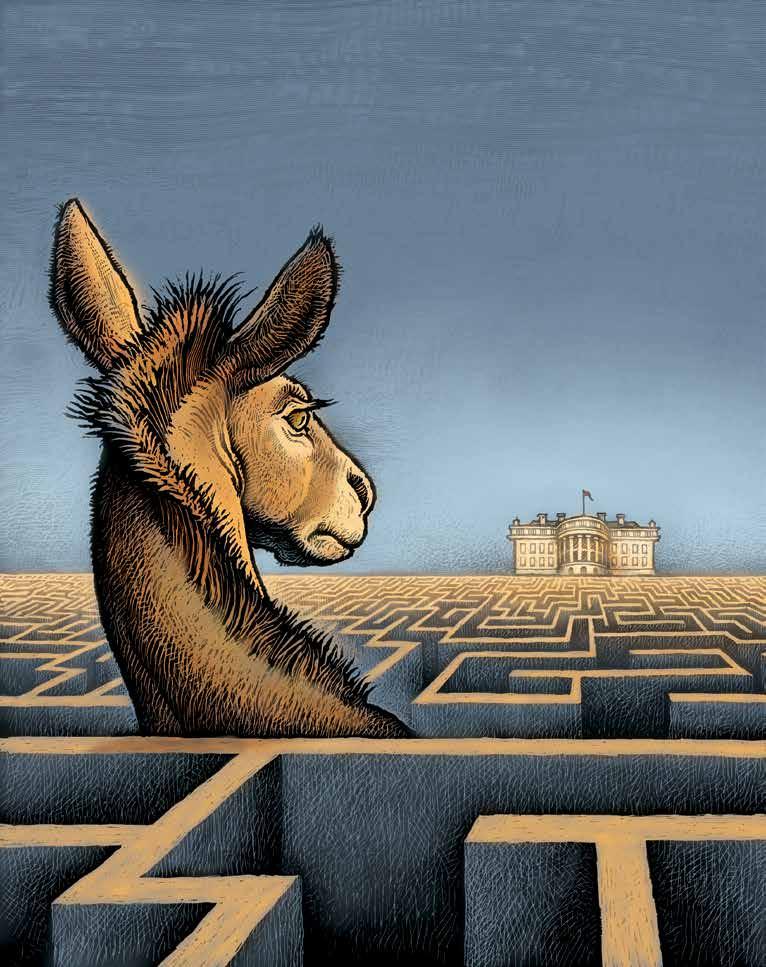
MARCH 2024 63 ILLUSTRATION BY PHIL FOSTER
democracy, which endured two decades, Democrats spoke for the newly emigrated, the working man and the small farmer against the merchant and banking class of northeastern Protestants. During Franklin Roosevelt’s New Deal, Democrats represented the “forgotten American” and “the people” against the “economic royalists” of Wall Street and corporate boardrooms. As Frances Perkins, Roosevelt’s secretary of labor, put it, “The ‘new deal’ meant that the forgotten man, the little man, the man nobody knew much about, was going to be dealt better cards to play with.”
Both the Jacksonian and the New Deal Democrats had their failings — and they were egregious in Jackson’s case. Jackson waged a brutal war against Native Americans and was a slave owner, but Jackson and Martin Van Buren, his political guru and successor, presided over the expansion of American suffrage and the birth of the modern American party system and defended the Union against the first threat of Southern secession. Roosevelt compromised with Southern segregationists to win needed support to pass Social Security and other pathbreaking measures. These measures vastly expanded the federal government’s responsibility for the welfare of its citizens, including the old and disabled. Roosevelt also signed legislation that enabled workers to vote for unions, laying the basis for the modern labor movement and for modern American pluralism, where labor could provide a countervailing force to the power of business. These reforms narrowed the gap between the people and the powerful. They contributed to decades of prosperity and to growing equality. They were as close as America has come to a social democratic politics and polity.
Over the last 30 years, the Democrats have continued to claim to represent the average citizen. In his 1992 campaign, Bill Clinton championed “the forgotten middle class” and promised to put “people before profit.” Barack Obama pledged that the “voices of ordinary citizens” would “speak louder” than “multimillion-dollar
donations.” Hillary Clinton in her 2016 campaign promised to “make the economy work for everyday Americans.” And Joe Biden was running in 2020 to represent “the people.”
“They’re the reason why I’m running. These are people that build our bridges, repair our roads, keep our water safe, who teach our kids, look, who race into burning buildings to protect other people, who grow our food, build our cars, pick up our garbage, our streets, veterans, dreamers, single moms.”
Biden’s appeal was clearly genuine, but over the last decades, Democrats have steadily lost the allegiance of “everyday Americans” — the working- and middle-class voters who were at the core of the older New Deal coalition. Initially, most of these
OVER THE LAST DECADES, DEMOCRATS HAVE STEADILY LOST THE ALLEGIANCE OF “EVERYDAY AMERICANS”— THE WORKING- AND MIDDLE-CLASS VOTERS THAT WERE AT THE CORE OF THE OLDER NEW DEAL COALITION.
voters were white, but in the last elections, Democrats have also begun to lose support among Latino and Asian working-class voters as well.
How did this happen? There is an original reason, for which the Democrats were hardly to blame. Democrats were the principal supporters of the Civil Rights Act of 1964 and the Voting Rights Act of 1965 — measures that went a long way toward ending racial segregation and Jim Crow, but that angered many Southern white people and, to a lesser extent, some white people in the North. “Well, I think we may have lost the South for your lifetime — and mine,” Lyndon Johnson told his aide Bill Moyers after he signed the 1964 bill. According to Moyers, it was said “lightly” and
was a “throwaway thought,” but it proved at least partly true. With the exception of a few far-right groups, however, Americans have reconciled themselves to those bills. Democrats regularly win elections in Virginia, the seat of the Southern Confederacy, and many of the northern and southern suburbs formed by white flight now vote for Democratic candidates. And Americans elected an African American president in 2008 and reelected him in 2012.
There is no single factor that has driven working-class voters out of the Democratic Party. They include:
• Democrats’ support for trade deals that led to factory closings in many small towns and midsize cities in states that were once Democratic strongholds.
• Democrats’ support of spending bills that the working and middle classes paid for but that were primarily of benefit to poor Americans, many of whom were minorities.
• Democrats’ support of immigration of unskilled workers and the party’s opposition to measures that might reduce illegal immigration.
• Democrats’ support for abortion rights (and opposition to any restrictions on these rights).
• Democrats’ support for strict gun control.
• Democrats’ support for and identification with the quest for new identities and lifestyles, particularly among the young, and denigration of all those who were not supportive.
• Democrats’ insistence on eliminating fossil fuels.
• Democrats’ opposition to open displays of religiosity.
• Democrats’ support for the desecration of national symbols, such as the flag or national anthem, to dramatize discontent with injustices.
• Democrats’ use of the courts and regulations to enforce their moral and cultural agenda, whether on the sale of wedding cakes or the use of public men’s and women’s bathrooms.
64 DESERET MAGAZINE
IDEAS
Not all Democrats are in line with these actions or beliefs. But overall, they came to characterize the party. Some of these stances have to do directly with economics; others with culture. The differences over them are often taken to distinguish the college-educated professional from those who do not have college degrees, but they equally, if not more accurately, arise from the differences in economic geography — what we call the “Great Divide” in American politics.
On one side of the divide are the great postindustrial metro centers like the Bay Area, Atlanta, Austin, Los Angeles, Chicago, Boston, New York and Seattle. These are areas that benefited from the boom in computer technology and high finance — the areas economist Robert Temin dubs “FTE,” for finance, technology and electronics. These areas are heavily populated by college-educated professionals, but also by low-skilled immigrants who clean the buildings, mow the lawns and take care of the children and the aged. The professionals, who set the political agenda for these areas, welcome immigrants who entered the country legally and illegally; they want guns off the street; they see trade not as a threat to jobs but as a source of less expensive goods; they worry that climate change will destroy the planet; and, among the young, they are engaged in an anxious quest for new identities and sexual lifestyles. A majority of them are Democrats.
If you want an extreme counterpart to Dundalk, it is Mountain View, a posh town (population 80,000) that is part of Silicon Valley. Alphabet (Google) and Meta (Facebook) are both headquartered there. Its main drag boasts chic boutiques and restaurants. Starter houses go for nearly $2 million, and rents run $3,000 a month for a one-bedroom. Many incomes are in the six-, seven- or more figure range. The area once leaned Republican. In 1980, Ronald Reagan defeated Jimmy Carter by 13 points in Santa Clara County. It is now overwhelmingly Democratic. Biden won 83 percent of the vote in 2020. Its congressman is Ro Khanna, who was national
co-chair of Bernie Sanders’ 2020 presidential campaign.
But its Democratic politics diverge from the older New Deal liberalism. His constituents, Khanna explained to us in an interview in his Capitol Hill office, are drawn to the Democrats primarily by social issues. They are “vehemently pro-choice, vehemently pro-gay marriage, vehemently for reasonable gun safety legislation. Yeah, vehemently pro-immigration in terms of recognizing that immigrants improve the nation and care deeply about climate.” Former Mountain View Mayor Lenny Siegel said about the politics of Mountain View’s residents, “They are progressive on national issues, but they don’t want to see dense housing built near them.” Mountain View
“THE DEMOCRATS ARE WHAT WE USED TO CALL THE JETSETTER CLASS. THEY ARE THE ONES WHO GO TO EUROPE ON VACATION. THEY ARE THE ONES WHO DON’T CARE WHERE THE STUFF IS MADE. I THINK THE WORKING CLASS HAS CAUGHT ON TO THAT.”
has a minimum wage of $18.15, but in 2020 its residents backed an initiative restricting parking by recreational vehicles (the only viable housing for many of the lower-wage service workers) in their small city.
The cost of housing is a big issue for young tech workers, but they are indifferent to labor unions. “The thing about tech people,” Siegel told us, “is that they can easily find another job if they are unhappy. If they stay at the same job for too long, it looks bad on their résumé. There is a lot of occupational mobility. People who are unhappy can solve the problem themselves.” That could change, of course, with the wave of layoffs that began in early 2023, but Siegel expects the downturn to be temporary.
On the other side of the divide are the small towns and midsize cities that have depended on manufacturing, mining and farming. Some of these places have prospered from newly discovered oil and gas deposits, but many are towns and cities like Muncie, Indiana; Mansfield, Ohio; and Dundalk that have lost jobs when firms moved abroad or closed up shop in the face of foreign competition. The workers and small-business people in these towns and cities want the border closed to immigrants who enter the country illegally, whom they see as a burden to their taxes and a threat to their jobs; they want to keep their guns as a way to protect their homes and family; they fly the American flag in front of their house; they go to or went to church; they oppose abortion; some may be leery of gay marriage, although that is changing; many of them or members of their family served in the military; they have no idea what most of the initials in LGBTQIA+ stand for. A majority of them are now Republicans and many are former working-class Democrats.
The underlying divisions are economic, but the political battles between the parties now manifest themselves as a continuation of the culture wars that began in the late 1960s. In the 2021 and 2022 elections, for instance, Democrats and Republicans fought over abortion rights, crime and the police, voter fraud and suppression, critical race theory, sexual education and border security. These differences between the parties and their candidates have been reinforced and hardened by what we call the “shadow parties.” These are the activist groups, think tanks, foundations, publications and websites, and big donors and prestigious intellectuals who are not part of official party organizations, but who influence and are identified with one or the other of the parties.
The labor movement used to play a dominant role in the Democrats’ shadow party and kept it rooted in working-class concerns, but it had to take second or third place during the Clinton and Obama years to Hollywood, Silicon Valley and Wall Street,
MARCH 2024 65
THEY HAVE SUCCUMBED TO WHAT WE CALL THE “FOX NEWS FALLACY” — NAMELY, THAT IF FOX OR THE WASHINGTON FREE BEACON DENOUNCES DEMOCRATS FOR THEIR STANCE ON CRIMINAL JUSTICE OR ILLEGAL IMMIGRATION OR GENDER AFFIRMATION, THERE CAN BE NO BASIS FOR THOSE CHARGES.
together with various environmental, civil rights and feminist groups. Currently, the shadow party includes organizations like the American Civil Liberties Union, the Sunrise Movement, Planned Parenthood and Black Lives Matter, publications such as The New York Times, MSNBC and Vox, foundations like Ford and Open Society, and think tanks like the Center for American Progress.
These shadow institutions have articulated the outlook of many young professionals in the large postindustrial metro centers and in college towns. On many of the cultural issues concerning race, gender and immigration that divide our politics, they have taken the most radical positions. Their counterparts on the right include the Koch Network, Heritage Foundation, the Center for Renewing America, Turning Point USA, Fox News, Breitbart.com and the Claremont Institute. These groups on the left and right subsist within their own closed universes of discourse, each shadow party using the extremes of the other to deflect criticism of their own radicalism.
With the parties at roughly equal strength — the Democrats’ losses in small-town America have been made up by their gains in the metro centers, and particularly in the suburbs — the parties have rarely enjoyed undivided rule. In the last 44 years, one party has held the White House and both houses of Congress in only 14 of them. The civics books will say that this rough equality encourages constructive compromise, but in the last three decades, it has more often been a recipe for gridlock and stalemate, epitomized in battles over increasing the debt limit and in repeated government shutdowns. This stalemate has increased voters’ distrust of Washington and of government.
In recent years, elections have increasingly been decided by which party can make the other party’s radical extremes or the politicians who represent those extremes the main issue. In 2016, Donald Trump succeeded in making the election about “Crooked Hillary.” In 2018 and 2020, the Democrats were able to make the election
about Trump’s excesses. In 2022, Democrats won elections where the issue was Republican opposition to abortion rights and insistence that the 2020 election was stolen, whereas Republicans won when the issue was Democrats’ wanting to defund the police or decriminalize illegal immigration.
THERE IS A danger to democracy lurking in this transformation of the parties into cultural warriors. American democracy was originally based on the Jeffersonian idea that roughly equal property ownership (by white males) would undergird political equality and democracy. That notion was dashed on the rocks of the industrial revolution, which created a society of distinct economic classes. It was then hoped by liberals and progressives in the early 20th century that the intrinsic economic and political power of the lords of industry and finance would be counterbalanced by the power of labor unions in the workplace and by a party that represents the working and middle classes in the political realm. And that was the democratic pluralism that, with some obvious flaws, New Deal liberalism bequeathed and that dominated American politics from the 1930s up through the 1960s.
But that hope for democracy has also been shattered. During the last half-century, the labor movement, under assault from business and Republicans, has precipitously declined, particularly in the critical private sector. And the Democratic Party has ceased to be seen and to function as the party of the people in competition with the party of business. The consequences have been profound. Business and finance, through a plethora of lobbies that began springing up in the 1970s, have gotten their way time and again. The tax code has been dramatically rewritten to favor the wealthy and corporations, including those with subsidiaries overseas, at the expense of working America; trade deals have been signed that have aided multinational corporations, investment banks and insurance companies but hurt American workers; finance, with its propensity to instability, and its emphasis
66 DESERET MAGAZINE IDEAS
on short-term returns, has been enhanced at the expense of manufacturing; at the behest of the most retrograde elements, social programs have been sabotaged or rejected that would have provided American workers with the same security in health care, child care and employment that European workers simply take for granted; and conservative court decisions have gutted post-Watergate measures designed to limit the inordinate influence of corporations and the wealthy on political campaigns.
In our view, one prerequisite for reviving the promise of American democracy is the reemergence of a political party whose primary commitment is to look after the country’s working and middle classes. It could be the Republicans who end up being this party. There are new intellectual currents within the Republicans’ shadow party that are skeptical about the reign of big business and free market ideology and endorse a version of industrial policy. These include the think tank American Compass and the journal American Affairs. We wish them well. But we worry that they will be ignored because of the Republicans’ traditional commitment to business and the strength of business groups and donors within the Republicans’ shadow party. That was evident in the new House Republican majority’s first act in January 2023, which was to slash funds for the Internal Revenue Service that had been targeted for uncovering tax dodging by the wealthy. The Republicans, too, have a radical side whose propensities for violence and contempt for democracy outweigh the foibles of the Democrats’ cultural radicals.
We place our hopes for change in the Democratic Party. We see evidence in the Biden administration’s first two years of a reevaluation of the party’s economic priorities on trade, taxes and labor, and on national economic growth that tries to bridge the Great Divide. The Democrats seem to have turned a corner from their deference to free markets and free trade during past administrations. The influence of Wall Street and Silicon Valley remains a problem
with the Democrats, but the main problem we see with today’s Democratic Party is the cultural insularity and arrogance that surfaced clearly during Hillary Clinton’s 2016 presidential campaign.
Most of the stands the party and its groups take on issues like race, crime, immigration, climate, sex and gender have a rational basis and justification. There has been police brutality; the country’s 11 million immigrants who have entered the country illegally constitute an exploitable underclass that needs to be integrated into society; transgender people have suffered discrimination; and climate change is a genuine threat to the planet’s future. There
THE DEMOCRATIC PARTY HAS HAD ITS GREATEST SUCCESS WHEN IT SOUGHT TO REPRESENT THE COMMON MAN AND WOMAN AGAINST THE RICH AND POWERFUL, THE PEOPLE AGAINST THE ELITE, AND THE PLEBEIANS AGAINST THE PATRICIANS.
are reasonable reforms that address these, but the radical solutions and the censorious outlook advanced by the Democrats’ shadow groups and by some Democratic politicians have been wrongheaded and divisive.
Many Democrats simply refuse to recognize this. Instead, they have succumbed to what we call the “Fox News Fallacy” — namely, that if Fox or the Washington Free Beacon or some Republican operative denounces Democrats for their stance on criminal justice or illegal immigration or gender affirmation, there can be no basis for those charges. Prior to the 2022 election, for instance, as Republicans were blaming Democratic support for defunding the police for a rising crime wave in big cities,
Democratic pundits and politicians derided the very idea of a widely documented crime wave. The Washington Post’s Philip Bump wrote a column aptly entitled, “Crime Is Surging (in Fox News coverage).” Democrats’ unwillingness to acknowledge the mote in their own eyes has hurt the party’s chances to win back working-class voters.
The America of today is vastly different from the America of the 1930s, but what the Democrats need today is a general approach to politics that is similar to that of the New Deal liberals. The New Deal liberals were liberal, progressive and social democratic in their economic views, dedicated to creating a better balance of power between labor and business and security against poverty, unemployment, disease and old age, but by today’s standards, the New Deal Democrats were moderate and even small-c conservative in their social outlook. They extolled “the American way of life” (a term popularized in the 1930s); they used patriotic symbols like the “Blue Eagle” to promote their programs. In 1940, Roosevelt’s official campaign song was Irving Berlin’s “God Bless America.” Under Roosevelt, Thanksgiving, Veterans Day and Columbus Day were made into federal holidays. Roosevelt turned the annual Christmas tree lighting into a national event. Roosevelt’s politics were those of “the people” (a term summed up in Carl Sandburg’s 1936 poem “The People, Yes”) and of the “forgotten American.”
There wasn’t a hint of multiculturalism or tribalism. The Democrats need to follow this example. They need to press economic reforms that benefit the working and middle classes, but they need to declare a truce and find a middle ground in today’s culture war between Democrats and Republicans so that they can once again become the party of the people.
EXCERPTED FROM “WHERE HAVE ALL THE DEMOCRATS
GONE?:
MARCH 2024 67
JOHN B. JUDIS IS EDITOR-AT-LARGE AT TALKING POINTS MEMO. RUY TEIXEIRA IS A POLITICAL DEMOGRAPHER AT THE AMERICAN ENTERPRISE INSTITUTE.
THE SOUL OF THE PARTY IN THE AGE OF EXTREMES,” BY JOHN B. JUDIS AND RUY TEIXEIRA. PUBLISHED BY HENRY HOLT AND COMPANY. COPYRIGHT © 2023 BY JOHN B. JUDIS AND RUY TEIXEIRA. ALL RIGHTS RESERVED.
BEYOND BORDERS
BY RAÚL LABRADOR
For over a decade, I practiced immigration law. As someone born in Puerto Rico who was raised by a single mom, I lived the American Dream, and it brought me great joy to help clients secure their chance to achieve it.
When I represented Idaho in Congress, I continually promoted the importance of legal immigration and the need to modernize our immigration system. But as I’ve watched the crisis at the border grow worse and worse over the last four years, it’s become clear to me that the American Dream is in peril.
There is good news, however, and it may come as a surprise: We don’t need Congress to pass new legislation to restore the integrity of our immigration system. The laws are already on the books.
In my work as an immigration lawyer, a congressman and now as the attorney general of Idaho, I know Americans want a fair and effective system of immigration. They understand the value of the entrepreneurs and hard workers who enrich and renew America’s promise. But the cornerstone of an effective system of immigration begins with securing the border and protecting American citizens.
Increasingly, citizens believe the federal government is failing in this duty. According to a CBS News poll released earlier this year, fully 70 percent of Americans disapprove of the way the current administration has handled immigration.
During my legal practice, I relied on the Department of Homeland Security to uphold the law to ensure my clients were pro-
FEDERAL LITIGATION TO STAUNCH THE BLEEDING IS CRITICAL BUT JUSTICE MOVES SLOWLY. WHAT IS A STATE TO DO IF IT HAS REASON TO BELIEVE THE FEDERAL GOVERNMENT IS FAILING IN ITS DUTY?
vided with due process and could navigate the legal system. In my later congressional role, I likewise relied on this same department to guarantee I could introduce meaningful legislation to amend our laws and improve our immigration system. But today many doubt the federal government is willing to uphold the laws already on the books when it comes to protecting the border.
The pictures along the border of Texas capture the enormity of the crisis. More than 7 million foreign nationals have been encountered at the border and countless more illegally entered the United States since January 2021. The cost of illegal immigration falls disproportionately on states like Texas. It’s reasonable that Texas and its citizens would want to take action. Yet as the state has recently acted to secure its border, this action was blocked in the courts at the request of the federal government.
It’s little wonder that no less than 14 governors recently went to the Texas border to make the case that the federal government must live up to its duty to protect and secure the border. As someone with decades of experience in this area, I don’t think it’s hyperbole to say the Biden administration is presiding over one of the worst immigration crises in our nation’s history.
And yet, the current confrontation in Texas is just the latest in a long line of actions that have fed the crisis. Border fencing comes on the heels of multiple lawsuits against the administration filed by Texas and a host of other states, including my home state of Idaho and its neighbor Utah. The goal of this litigation is simple
68 DESERET MAGAZINE
THE IMMIGRATION CRISIS HAS REACHED A TIPPING POINT. FIXING IT ISN’T AS HARD AS IT SEEMS IDEAS

— to ensure the administration follows the law as Congress has prescribed.
Attorneys general from all over the country, including me, have signed their names to complaints asking the court to stop unlawful immigration policies and to compel the administration to act as required by law.
Texas’ attempt to control its borders constitutes lawful state action to further a compelling interest, especially when considering the cost of illegal immigration. As Texas is ground zero for many who enter the country illegally, the unpredictable influx wreaks havoc on state and local budgets.
Resources dedicated to public safety and public health are stretched thin and those who settle in the state and utilize the public school system are not accounted for in annual budgets. The results are a diminishing ratio of tax dollars per each student, longer waits in emergency rooms and insufficient municipal services to cover an ever-growing population. The country was stunned when New York City was forced to cancel classes at some area schools due
to migrant housing, yet Texas has balanced these competing interests every day for over three years.
Federal litigation to staunch the bleeding is critical, but justice moves slowly. As conditions along the southwest border continue to deteriorate, Texas asserted a right to protect its borders. This, of course, is the federal government’s responsibility. But what is a state to do if it has reason to believe it’s failing in this duty?
The month prior to the administration acting to block this more proactive state response, the Department of Homeland Security announced the southwest border saw over 302,000 border encounters in December 2023 — a new record.
Since President Joe Biden’s inauguration, Customs and Border Protection has encountered more than 7 million foreign nationals at or between the ports of entry, with hundreds of thousands of others successfully eluding U.S. Border Patrol. During fiscal year 2021, Customs and Border Protection also saw a marked uptick in
MIGRANTS CROSS THROUGH A GAP IN THE U.S.-MEXICO BORDER FENCE ON JANUARY 3, 2024, IN JACUMBA HOT SPRINGS, CALIFORNIA.
MARCH 2024 69
PHOTOGRAPHY BY QIAN WEIZHONG
border rescues with more than 12,000 individuals requiring medical assistance. That nearly doubled to more than 22,000 in FY 2022, before exceeding 37,000 in FY 2023.
Perceptions matter, and the prevailing perception is that the United States is effectively opening the door to entrants at and between the ports with lax border policies. But the laws passed by Congress outline what the federal policy should do: protect and secure the border.
Illegal immigration has long been a concern and Congress has taken action with amendments to the Immigration and Nationality Act and other independent bills. In 2006, for example, Congress — including “yes” votes from then-Sens. Biden and Barack Obama — passed the Secure Fence Act. This bipartisan legislation defined operational control of the border as the “prevention of all unlawful entries into the United States.” With this mandate in effect, it remains deeply confusing to witness executive orders on immigration directing relevant agencies to find ways to apparently remove barriers to illegal entry.
Operational control, as defined, may be aspirational, but prior to the pandemic,
then-President Donald Trump’s Department of Homeland Security used every lawful tool available to achieve it. Utilizing statutory authority such as the Remain in Mexico program and creating bilateral agreements with Central American partners, individuals attempting to enter the United States no longer found a guaranteed free pass to indefinite residence. They were stopped, given due process as required under law, and were either granted the ability to remain legally in the United States or were quickly removed.
Biden’s approach to the situation is a significant departure from the statutory definition of operational security. His Department of Homeland Security, for example, halted all deportations for at least 100 days in the early days of his administration. Through the use of regulatory amendments, the administration also broadcast its position that all those entering the country at the southwest border were valid asylum applicants. The White House likewise invited more illegal immigration to our borders by reassigning certain authorities and making broad-based changes to the law. The resulting changes were in

direct conflict with federal law and with the standard operations at the border and have further destabilized the situation.
While few would deny that the immigration system needs improvements, the Biden administration has over-relied upon “broken immigration system” rhetoric while overseeing the largest continuous rush of illegal immigration in our nation’s history. The president has made it overwhelmingly clear that our borders are open, that those entering the country illegally will be rewarded, and that those that enter and remain in the United States illegally will face no consequences.
So, what is the answer? Laws can always be amended and improved, but passing new legislation means nothing if the executive branch refuses to follow either the letter or the spirit of the law. It’s time to step back, and let core principles be put into play — including a respect for the rule of law, the role of the federal government to secure its borders, and the role of states to protect their citizens.
Many are unaware that a system exists to quickly process individuals at the border, which includes a near-immediate, initial evaluation of any claims for asylum. But according to a recent report by the House Judiciary Committee, this process is used only sparingly, for approximately 6 percent of individuals encountered.
These congressional findings, combined with a lax posture toward the law, suggest new legislation granting additional executive authorities is not the answer. While our immigration laws are not perfect, and most sensible Americans are in favor of updating them, what we need now is greater border security. And in the absence of congressional action or judicial accountability, it falls on the states to ensure that their citizens are secure. That’s why I, and so many others, are standing with the state of Texas in its efforts to protect Americans.
70 DESERET MAGAZINE IDEAS
RAÚL LABRADOR HAS SERVED AS THE ATTORNEY GENERAL FOR THE STATE OF IDAHO SINCE 2022. FROM 2011 TO 2019, HE WAS THE U.S. REPRESENTATIVE FOR IDAHO’S 1ST CONGRESSIONAL DISTRICT.
HOMELAND SECURITY REPORTED A RECORD 302,000 ENCOUNTERS AT THE U.S.-MEXICO BORDER IN DECEMBER 2023.

REWRITTEN
SHOULD HOLLYWOOD TELL US HOW TO THINK ABOUT OUR OWN HISTORY?
BY ETHAN BAUER
On screen, a gray-haired tribal elder leads a mournful chant, raising a pipe toward the open chimney of a dome-shaped Osage lodge. “The children outside listening, they will learn another language,” he says, via subtitles. “They will learn new ways and will not know our ways.” Others sob as a woman cradles the pipe, now bundled, as if it was a dead child. They follow her outside to bury the bundle in a green field, but the ritual is interrupted by rumbling from the earth. A black spout erupts. Oil speckles the chests of young men who start to dance. A guitar riff flags “Killers of the Flower Moon” as a modern and original film, but these characters seem quite aware of their place in history.
The discovery of oil in 1894 made the Osage the “richest people per capita on Earth,” after seven decades of hardship on reservations in Kansas and Oklahoma. A newsreel-style montage shows them playing golf in tailored clothes, attending stately schools and riding in Pierce Arrow limousines. A black steam engine huffs into the frame, stopping at a frontier railway station. Well-heeled Osage families spill from the
train beside rough-hewn white men wearing Stetson hats and bandanas around their necks. These images signal that this is a Western, a tale of cowboys and Indians, but not like the viewer is used to.
The film follows an outlier clad in olive drab. Ernest Burkhart, played by Leonardo DiCaprio, is a World War I veteran coming
“FRONTIER HISTORIES CAN BE TOLD AS TRIUMPHANT AMERICAN WESTWARD EXPANSION OR AS FOREIGN INVASION. PERSPECTIVE MATTERS.”
to work on his uncle’s cattle ranch. Viewers watch him develop ties on both sides of a growing conflict, raising a family and navigating a grisly caper. Director Martin Scorsese, a mafia movie virtuoso, purports to illuminate a dark corner of American
history by faithfully portraying these events as documented in the eponymous book by journalist David Grann, citing an assist from members of the Osage Nation. But he also aims to upend the way Americans view their own history.
People love historical epics. Just browse this year’s Academy Awards nominations. “The Zone of Interest” follows an Auschwitz commandant home during the Holocaust. “Oppenheimer” explores the moral implications of the atom bomb through the man who ushered it into existence. “Maestro” studies the life of Leonard Bernstein, the great 20th century composer. “Golda” portrays Israeli prime minister Golda Meir through the Yom Kippur War. And “Napoleon” gives the French emperor the blockbuster treatment, centered on his imagined romantic life. Each has been nominated in at least one category and has enjoyed varying degrees of commercial success.
Scorsese, whose best director nod is one of the film’s 10 nominations, has grander ambitions for “Killers of the Flower Moon.” He intends to “correct” the historical record — especially Hollywood’s demeaning
72 DESERET MAGAZINE
CULTURE

MARCH 2024 73 ILLUSTRATION BY GREG MABLY
portrayals of Native Americans — and ask viewers to reimagine America’s westward expansion through the lens of a true crime saga, the dispossession of one last tribe amid the Old West’s dying embers. He largely does this with one simple maneuver: choosing a story where cowboys are not the good guys. This essay is not an endorsement of that film, but an exploration of his project and what it means to argue about the past.
THIS ISN’T EXACTLY new. We’ve been fascinated with history for longer than we can remember.
New research shows that native Tasmanians still share oral histories that originated at least 12,000 years ago. Once writing systems developed in early Egypt, Mesopotamia and Sumeria, around 3,500 B.C.E., those civilizations started keeping chronological annals. Sanskrit tales of wars and deities arose in the Indus River valley by the late Bronze Age, roughly concurrent with the biblical conquest of Jericho and the Trojan War depicted in Homer’s epic poems. “The Iliad” and “The Odyssey” were probably written during the eighth century B.C.E., about 400 years after the fact, but their narratives still resonate today, although the details are largely fictitious.
We still devour historical fiction in any form, from Shakespeare’s plays to the Vietnam War novels of Tim O’Brien and Broadway’s “Hamilton,” created by Lin-Manuel Miranda. “Historical fiction comes out of greed for experience,” observed historical novelist Hilary Mantel. “Violent curiosity drives us on, takes us far from our time, far from our shore, and often beyond our compass.”
On the other hand, our modern conception of the historian likely dates to the fifth century B.C.E., when Herodotus undertook the field’s first systematic investigation. In researching “The Histories” — from the Greek for “inquiries” — he set out to chronicle the Greco-Persian Wars, and the geographic and cultural reasons they were fought. In his own words, he wrote “so the memory of the past may not be blotted out
from among men by time, and that great and marvelous deeds done by Greeks and foreigners and especially the reason why they warred against each other may not lack renown.” Critics later accused him of publishing poetic “fables,” but that only cements his place as the father of history.
Because as long as we’ve cared about history, we’ve been fighting about it. And that’s OK
What we learn in school is history for children, often presented as an undisputed sequence of events tracking the march of progress through the accomplishments of great men and women. But the practice of history — more specifically, historiography, which is the writing of history — is one of exploration, making sense of what happened using the best available evidence, but also searching for better data and questioning underlying assumptions. Sometimes, this can make us uncomfortable, or undermine a deeply held narrative, eliciting accusations of “political revisionism.”
“NO ONE GOES TO A MOVIE EXPECTING A HISTORY LECTURE.”
Certainly, history can be a powerful political tool. As George Orwell wrote in “1984,” the classic dystopian novel: “Who controls the past controls the future. Who controls the present controls the past.” But some revisions stem from societal change. Demographic shifts have encouraged historians to explore the historical perspectives of women and diverse ethnic and socioeconomic groups. Rather than study monarchs, wars and plagues, historians today often focus on the lives of the poor, oppressed and vanquished, searching for untold stories and surprising points of view.
These evolutions may feel refreshing to some, even empowering; to others, they can feel like a threat. History is essential context, forming the intellectual landscape we navigate. For much of our history, “mainstream”
Americans shared a common understanding of both the factual record and what it meant. In today’s fractured world, that kind of surety sounds like a distant dream, or perhaps a limited experience that not all could share. Still, when narratives that have shaped our inner lives are torn down, it can feel as disorienting as walking around a city where familiar and emblematic buildings have been replaced with stucco apartments.
BURKHART DRIVES AN early automobile, flirting over his shoulder with his passenger, Mollie Kyle. Played by Lily Gladstone, the first Native American actress nominated for an Oscar, she seems skeptical as he playfully probes her defenses. When she lashes out in her mother tongue, he charmingly assumes it was “Indian for handsome devil.” She doesn’t see him out at night with his friends, robbing “rich Indians” at gunpoint and gambling away the take, but she distrusts his uncle — who calls himself “king of the Osage hills” — and senses ulterior motives. “Coyote wants money,” she tells him.
This sequence overturns an old Hollywood trope that was not based in fact. The “squaw” (now deemed an ethnic and sexual slur) was a wife-like figure, but powerless, submissive, typically silent and often treated as property. In reality, women had different roles from tribe to tribe. Some were focused on domestic life; some became spiritual leaders; and in some matriarchal cultures, they made the decisions. These nuances were not available to the makers of early Westerns. But here, Kyle wields her own power as an heir to oil money, while her Catholic school education far outstrips Burkhart’s limited literacy. More importantly, she is a three-dimensional character, which is sadly still a novelty in the genre.
It’s unclear whether the flattening of Native American characters was driven more by lack of information or the market of viewers, but it’s interesting to note that some early films took a different approach. “The Squaw Man,” from 1914, tells a tragic tale of star-crossed love between the daughter of a Ute chief and an upper-class English
74 DESERET MAGAZINE
CULTURE
rogue. In 1930’s “The Silent Enemy,” members of the Ojibwe tribe — played by Native American actors — struggle to survive a famine. But that changed in 1939, when a film set in southern Utah invented the Western as we’ve known it.
That’s when John Wayne first rode across Monument Valley in “Stagecoach,” directed by John Ford. As the Ringo Kid, an outlaw with a heart of gold, Wayne helps a group of naive travelers to survive a trek across dangerous Apache country, with comic relief from Andy Devine. The Apaches appear as little more than a natural menace, about as thoughtful as wolves or a tornado. The movie holds up as a work of cinematic art, but its success spawned or advanced harmful cliches that persist today. Ojibwe critic Jesse Wente has called it “the most damaging movie for native people in history.”
The “Hollywood Indian” became a staple on movie sets, wearing feathers, beads, warpaint and leather britches. Personas varied, from muted stoics like Tonto in “The Lone Ranger” to nihilistic brutes hell-bent on violence, represented by hundreds of nameless characters shot dead in the attempt. A few sympathetic or respectable exceptions were played by Mexican actors, like Anthony Quinn and Ricardo Montalbán, or white actors in redface, from Burt Lancaster to Burt Reynolds and Elvis Presley. As if real-live Native Americans had ceased to exist, leaving only “Stagecoach” as a record of their passing.
These tropes appealed to many Americans and it’s worth understanding why, beyond blaming racism. The prototypical Western plot follows an everyman type who struggles against forces of savagery or greed to find a home, a sanctuary in a violent wilderness that is slowly being civilized through the perseverance of his people. Versions of that tale exist in many of our family histories, told from a familiar viewpoint. The archetype argues that westward expansion was benevolent and just, so any violence perpetrated in its service was justified. It allows us to see ourselves as would-be heroes, even if our ancestors were simple dirt farmers.
It’s less comforting to watch Burkhart plot with his uncle, “King” William Hale, played by Robert De Niro, to steal Osage land and the petroleum beneath it through a scheme of marriage and murder.
GATHERED IN A large wooden lodge worthy of the tribe’s wealth, Osage leaders discuss a spate of murders, unaware that the man directing them sits in their circle. One blames white opportunists who are “like buzzards circling our people” who “wanna pick us body clean, leave nothing.” A reward has been posted and Mollie — now married to Ernest — confirms that she has hired a private investigator. Hale volunteers a $1,000 donation to help the effort. He doesn’t mention that the killers are working for him, following his orders. “Your friendship has always been greatly appreciated,” the chief tells him.
This ongoing deceit and violent chicanery offer a microcosm of our national myth from a different point of view, standing in for the broken treaties, smallpox blankets and bloody massacres that made Manifest Destiny a reality on the ground. “It’s like lifting up the lid and saying, ‘This is your American history. This is what you didn’t learn in school,’” said film critic Richard Brody during a New Yorker Q&A. “‘This is what our society now is built on and doesn’t dare look in the face.’” Scorsese answered: “Exactly.”
Scorsese is one of the great directors, but he is not a historian. He has made a litany of classic films, but how much credence should we put into his effort to change history? Is he right? Brenden Rensink, associate director of the Charles Redd Center for Western Studies at BYU, suggests a different way to think about it. “Frontier histories can be told as triumphant American westward expansion or as foreign invasion,” he says. “Perspective matters.”
Rensink reminds us that “most art reflects contemporary concerns.” To understand a film like this, we should think about the context in which it was made, rather than the events it depicts. In politics today, competing historical narratives are used to
justify opposing sides in the Russia-Ukraine war and the conflict between Israel and Hamas in the Gaza Strip. American politicians on the campaign trail still debate what led to the United States Civil War. If your head is spinning now, maybe it should be. But that doesn’t mean it’s not worth visiting another point of view, even if it’s not particularly scholarly.
One reason narratives are so powerful is they allow us to experience something through the eyes of another. Even when that character is fictitious, this phenomenon can help us to practice or develop empathy. That said, Rensink cautions that entertainment is best as an entry point to any given topic. The next step requires effort on our part, engaging the material with critical thinking and historical context. “There’s nothing wrong with pop culture that simply entertains, but if it sneaks distorted historical narratives into our collective consciousness — like a Trojan horse — then it can actually cause damage.”
Steven Mintz, a historian at the University of Texas at Austin, thinks most people understand the distinction. “No one goes to a movie expecting a history lecture,” he says, referencing invented dialogue, composite characters, contrived episodes and the projection of current sensibilities onto past events. Still, an engaging narrative can help us to learn. “At their best, these films generate interest in the past and raise profound questions about morality, inevitability and the influence of character upon history, and prompt viewers to read more.”
Without giving away the plot, the Federal Bureau of Investigation eventually takes an interest in the Osage killings. Cases are brought to trial, hard questions are asked and answered to varying levels of satisfaction and certain characters are sentenced to lengthy prison terms. Then, abruptly, the camera cuts to Scorsese himself. In the role of an old-time radio narrator, he concludes by reading Mollie Kyle’s brief, real-life obituary, noting pointedly that “there was no mention of the murders.”
MARCH 2024 75
GOOD ENOUGH
AN ODE TO THE COSTCO ROTISSERIE CHICKEN
BY NATALIA GALICZA
There are no surprises in these stacks of rotisserie chickens, but I inspect them anyway, as if one could be more perfect than another. Each bird is about three pounds, with crispy skin that glistens golden brown, soaking in a pool of warm oil like a private jacuzzi that steams up each plastic case. Perhaps I should be put off by the sameness of my options, the lowest-common-denominator quality of a product this unashamedly mass-produced, the long-term impact on my cardiovascular health. But I’m young and healthy, so the fact that each chicken I hoist at my new Costco in Salt Lake City feels just as it would back home, some 2,500 miles away in Florida, feels good enough.
In case you’re not familiar, Costco is an international chain of warehouse-style wholesale stores and a symbol of American-style consumerism, where small businesses and large families stock up at bulk discounts. But what makes it feel like Costco — beyond the indulgent cart sizes — is the sameness of the products. The rotisserie chicken, famously tucked beside the deli meats at the back of each store, is the same in New Jersey as it is in Japan. And the prices are just as unyielding. Through a global pandemic, record job losses and the worst inflation the United States had seen in decades, these chickens stayed firm at $4.99. That, alone, can be comforting.
And people love it! People have created Facebook fan pages for the Costco rotisserie chicken. They wear T-shirts bearing the product label. They’ve posted YouTube videos of themselves or others feasting on two at a time. That love is enough to transcend the company’s $60 annual membership fee, even in hard times. In 2020, amid record job losses and rolling lockdowns, Costco sold 101 million rotisserie chickens. That number rose to 106 million in 2021, then 117 million in 2022. That’s a lot of birds!
The chicken didn’t bring me to Costco today. It never does. But now the perfume of grease and herbs takes me home, where iterations of this poultry have shown up at family dinners across South Florida for as long as I can remember. My grandmother would crack open bones for a shot at the marrow; my father would pick apart the meat to make croissant sandwiches. “You can put it in soups, sandwiches, eat it with rice, eat it on its own,” he told me years ago, when he first gave me a membership card. It’s the avian embodiment of utility and convenience.
As I place my chosen bounty in my shopping cart, it feels like instant relief. I don’t have to wonder how I’ll use it because it doesn’t matter. I know that I will. It’s one less thing to acclimate to. And that’s good enough.
76 DESERET MAGAZINE CULTURE

MARCH 2024 77 ILLUSTRATION BY LEXI NILSON



THE MOVEMENT TO ACCELERATE CANCER RESEARCH














Right now, most clinical information is not regularly shared with the researchers who are trying to uncover new information about cancer every day, but you can help change that. Patients can help accelerate research by sharing their data and unique experiences.


When patients stand together with researchers, they can unlock new discoveries and treatments. People with all types of cancer may be eligible to join Stand Up To Cancer, Count Me In and more than 7,500 patients who have already participated in this mission to accelerate the pace of cancer research.

Find out more and sign up to join the movement at StandUpToCancer.org/CountMeIn







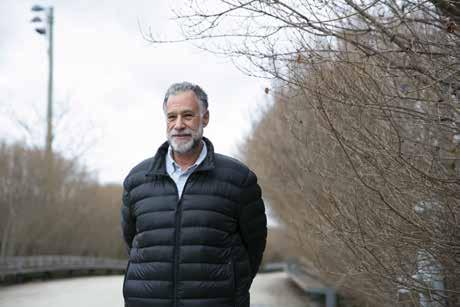


 Uzo Aduba Stand Up To Cancer Ambassador
Uzo Aduba Stand Up To Cancer Ambassador
Stand Up To Cancer is a division of the Entertainment Industry Foundation (EIF), a 501(c)(3) charitable organization. JOIN
Photo By Matt Sayles
ENGLISH
BY NANCY TAKACS
I used to feel the subject was nothing, studying my own language, so easy. I thought I knew everything, remembering all of the forms of to be, that am is a verb.
I was able to juggle a present participle among the pluperfect on tests. In eighth grade, strict Sister Rose made us write an essay about ourselves. I started with the title
but couldn’t think of one. I hated the personal, thought like my mother who said to keep my mouth shut because she always said too much
and got in trouble. I got a D for rambling. Tonight is so clear the sky is shiny, unbreakable. It soothes my shoulders, soothes the braided rug.
I think of ordering a lampshade with a clipper ship, its base a pretend telegraph, and a table of willow sticks. I’ve always loved codes, forms,
diagrams like fishing lines dangling from the subject and predicate, which could finally be caught from the mystery of syntax,
to be erased, thrown back, to go on living somewhere invisible. Then in ninth grade, Mrs. McCarthey, with her disheveled blouses and crowded teeth,
assigned a poem, with a metaphor, not about me, but a body of light. I wrote about Venus, her distance and electricity.
FIRST PUBLISHED IN RUMINATE
MARCH 2024 79 POETRY
TAKACS IS THE AUTHOR OF SEVERAL BOOKS OF POETRY, THE LATEST OF WHICH IS “DEAREST WATER.”
NANCY
CURATED BY UTAH POET LAUREATE LISA BICKMORE

PAY IT FORWARD
SHARING THE LESSONS OF FINANCIAL FREEDOM WITH DISADVANTAGED COMMUNITIES
BY LOIS M. COLLINS
Michelda George’s love affair with finance began with an intervention. In her mid-20s, she was in a very different place. The first-generation Haitian American was deeply in debt, with a poor credit score and unpaid traffic tickets in her glovebox, while she somehow scraped together enough for a vacation or a night out with pals. One of her five older brothers, Peter, stepped in. He shamed her into parking her car and using a bike. He put her on a stringent spending diet: Just $25 from each paycheck was hers to use as she wished. It was tough, but worth the unexpectedly joyful reward: freedom.
Now George, 37 and newly married, is dedicated to helping others to achieve that. That makes her a natural fit for a strategic program manager role in Gov. Spencer Cox’s Utah Small Business Credit Initiative — especially because the program serves underrepresented and underserved communities. Growing up in South Florida, she doesn’t recall anyone trying to help those in her community to qualify for loans with decent interest rates or learn to budget, save
and invest. She’s excited to fill that gap for other historically marginalized communities, typically defined by race, ethnicity, geography, economics, gender, veteran status and LGBTQ orientation. As a person of faith, she sees it as her calling.
Deseret talked to George about how some communities get left behind.
“BLACK PEOPLE IN THIS COUNTRY HAVE FALLEN IN BETWEEN THE CRACKS. AND THAT IS NOT SOMETHING THAT CAN JUST BE SWEPT UNDER THE RUG BECAUSE THERE ARE SUCCESS STORIES.”
YOUR BROTHER’S APPROACH WAS HARSH. DID IT WORK?
He helped me get on this financial trajectory, to learn how to save and invest and live on a budget and live below my means. It was
a spiritual experience because five years later, it gave me the opportunity to know what it was like to be debt-free and in control of my life. If a work environment is toxic, I’m out. My car’s paid off. I have nice savings. I have credit. I’ll work at 7-Eleven or McDonald’s until I find another job. It empowered me. That’s when I learned that financial literacy and education generally impact every other area of our lives. They can determine what we have access to, what our life experiences are. I wondered, could this be something I could do as a profession? Because I’d love to be able to set people free.
WHERE DID YOU BEGIN?
I started watching “CNN Money” segments on TV and paying attention to the titles of the people that were on those shows. I started looking into those job roles. That’s how I ended up working at a private equity firm; being a life insurance agent gets you on that path. I was working under senior financial advisers, collecting data and doing interviews with people to find out where they were financially so that we could build
80 DESERET MAGAZINE
THE LAST WORD
MICHELDA GEORGE
that five-year plan in the computer. And I was like, this is not as out of my reach as I thought. Then I wanted to move up. I’ve been in what they call the financial services industry now for going on five years.
WHY IS IT IMPORTANT TO NURTURE ENTREPRENEURSHIP IN DIVERSE COMMUNITIES?
When you work in financial services, you start to see that this world is majority white males. It’s like that across the country. In my experience, I’m talking about South Florida, a place where it’s extremely diverse. It’s not like there are not Hispanic, Asian, Pacific Islander, Black people, Indigenous people inhabiting this space; there are plenty of them. But if you go downtown and into these finance institutions, you will see that most people in these roles are white, and they’re probably 45, 50, 60 years old. I want to emphasize that because I’ve had a lot of people say, “Well, you’re saying that because you’re Black. You’re using that as an excuse to market yourself in this way.” No, this is the reality.
I also noticed that no one was coming into our communities, knocking on our doors to say, “Hey, let me help you.” We had a group of agents that did door-to-door knocking; it was similar to real estate, where you go and say, “Hey, are you interested in selling your home?” They were not deployed to the Black and brown communities that were just three blocks away. So I started hosting free financial literacy workshops at our brokerage on the weekends when nobody was there. I was able to get quite a few clients to sign up for life insurance and, like, that starter package: the foundation, working on their budget, finding out what 401(k) plan they had at their job. I wasn’t a licensed investment person, so I couldn’t advise them on what to invest in. But if they weren’t taking advantage of their 401(k), I would tell them, you need to sign up. It was basic: Save for a rainy day. Then I started going to universities, saying: “Hey, can I come teach your college kids about credit and how to budget and how
to take advantage of scholarships and try not to get into debt? Because it’s possible.” There was a huge need.
WHY ARE FINANCIAL BASICS SO HARD TO FIGURE OUT?
They may have never heard about life insurance. They may not have ever heard the word investment, or 401(k), or asset management or a trust. So you’re trying to tell people to go online and research a word they did not even know exists. That’s why people are saying that representation matters, that the influence of environment and parents matters, because you raise your children in the way you want them to go. But when you have access to information, that’s what flows through your family. We can’t say all struggle because there are some successful Black professionals, entrepreneurs and businesses. And there are countries that are successful. Africa has good infrastructure in some areas where people are educated well. I don’t want to say all, but just historically, we know that a large majority of Black people in this country have fallen in between the cracks. And that is not something that can just be swept under the rug because there are success stories. Because that’s not fair.
HOW DO YOU PERSONALLY HELP PEOPLE TO FIGURE OUT SOME OF THESE CHALLENGES?
For me, it’s more soul-driven. I have a strong desire to serve people. Honestly, I know what freedom felt like, for me to be financially in a place where I no longer had to go into a toxic job. I literally don’t. If I can get the people that I interact with to that point where it clicks for them, they’ll know what freedom feels like. Once you feel like you’re in complete control of your life, that you get to decide and dictate what kind of food you want to eat, or where you want to travel, whatever that is for you that makes you happy. When you can do that and not live anxiously from paycheck to paycheck. I know what that felt like and meant for me to be able to dictate my level of care in every area of my life. It felt like freedom.
“THAT’S WHEN I LEARNED THAT FINANCIAL LITERACY AND EDUCATION GENERALLY IMPACT EVERY OTHER AREA OF OUR LIVES.”
MARCH 2024 81
ILLUSTRATION BY KYLE HILTON

82 DESERET MAGAZINE PARTING SHOT
PHOTOGRAPHY BY MICHAEL SIMMONS
COSMIC DANCE, BIG BEND NATIONAL PARK IN TEXAS.


Peripheral Arterial Disease (PAD) is a leading and preventable cause of death in the U.S.


taking a break due to leg pain.




Have pain, numbness, or cramping in your legs or feet.
Have been treated for neuropathy and are still experiencing symptoms…




You may have Peripheral Arterial Disease (PAD)—a life threatening condition. However, if caught in time, PAD can be treated without the need for invasive surgery or general anesthesia.
our o ce today to set up a consultation with one of our providers, your family, friends and loved ones will thank you for it. Most insurance and Medicare accepted.











IF YOU…
(866) 668-8677 pad101.org cicmedical.com
YES NO YES NO YES NO
Joel Rainwater, MD • Ryan G. O’Hara, MD • Michael Switzer, MD • Brian Evans, MD • Dr. Grant Fankhauser Utah, Arizona, Nevada, & New Mexico
Contact
“Engaging in activities devoid of di culty, lounging in risk-free zones, is life without great meaning.”
— Jon M. Huntsman Sr.


To learn more, please visit: Huntsman.usu.edu email Huntsmaninfo@usu.edu or call 435.797.0155
PLUS:
MIKE LEE ON PUBLIC LANDS & RAÚL LABRADOR

SPECIAL ISSUE STATE OF THE WEST
THE GREAT CALIFORNIA EXODUS
BAD BETS : HOW VEGAS IS TAKING OVER SPORTS
THE OTHER MARCH MADNESS ALASKA’S MOST REMOTE (AND INSPIRING) BASKETBALL TOURNAMENT
MILITARY SPENDING — BAILOUT OR FALLOUT?
deseret.com $4.95
2024 VOL 04 | NO 32
MAGAZINE UPC REFERENCE MARCH JULY APRIL SEPTEMBER MAY OCTOBER
MARCH
DESERET
ON IMMIGRATION
MARCH 2024 I SSUE 32 32


































 I, ROBOT
I, ROBOT



















 BY Natalia Galicza
ILLUSTRATION BY Mike McQuade
BY Natalia Galicza
ILLUSTRATION BY Mike McQuade





































 Uzo Aduba Stand Up To Cancer Ambassador
Uzo Aduba Stand Up To Cancer Ambassador



























